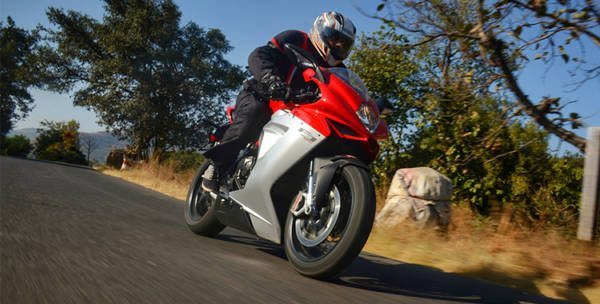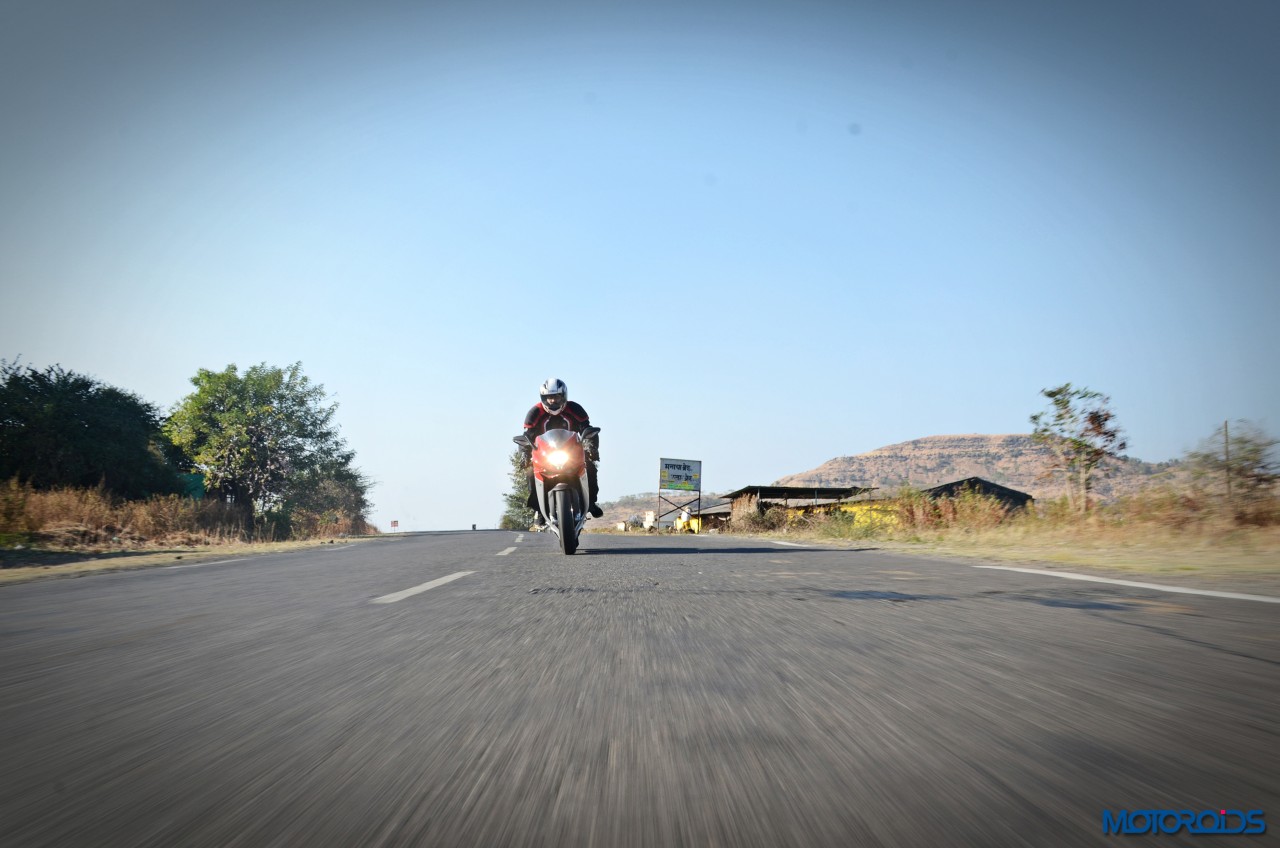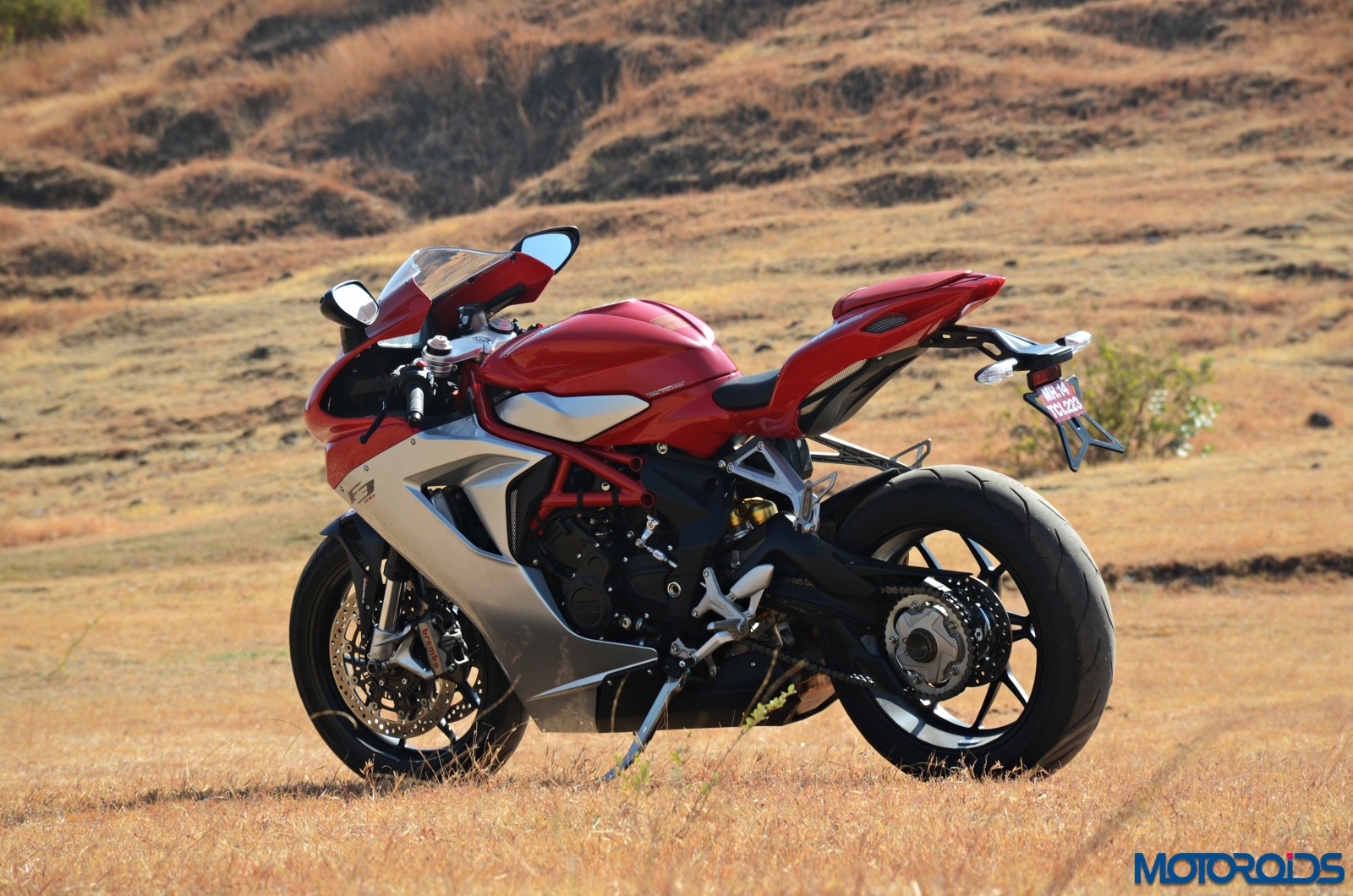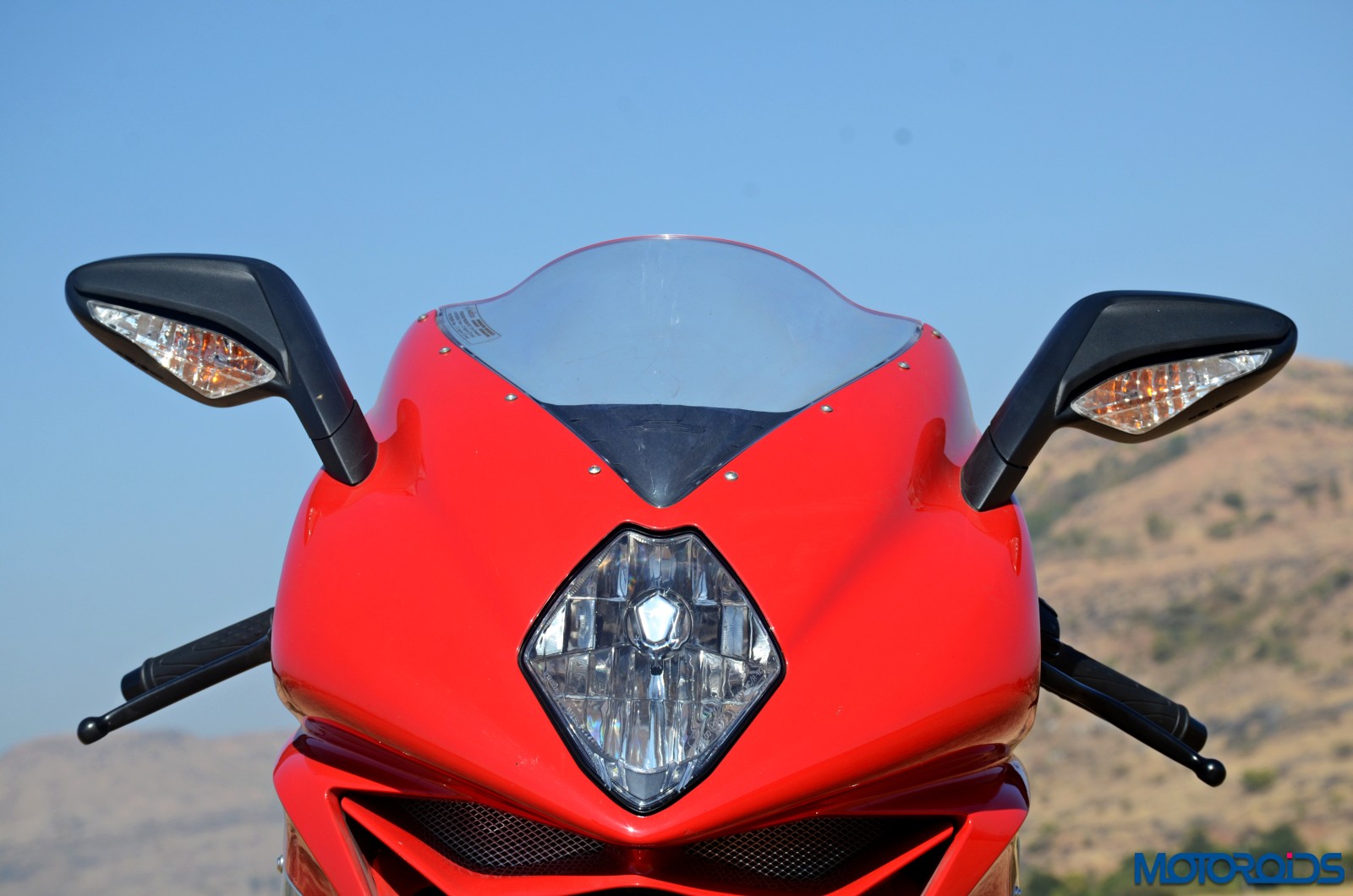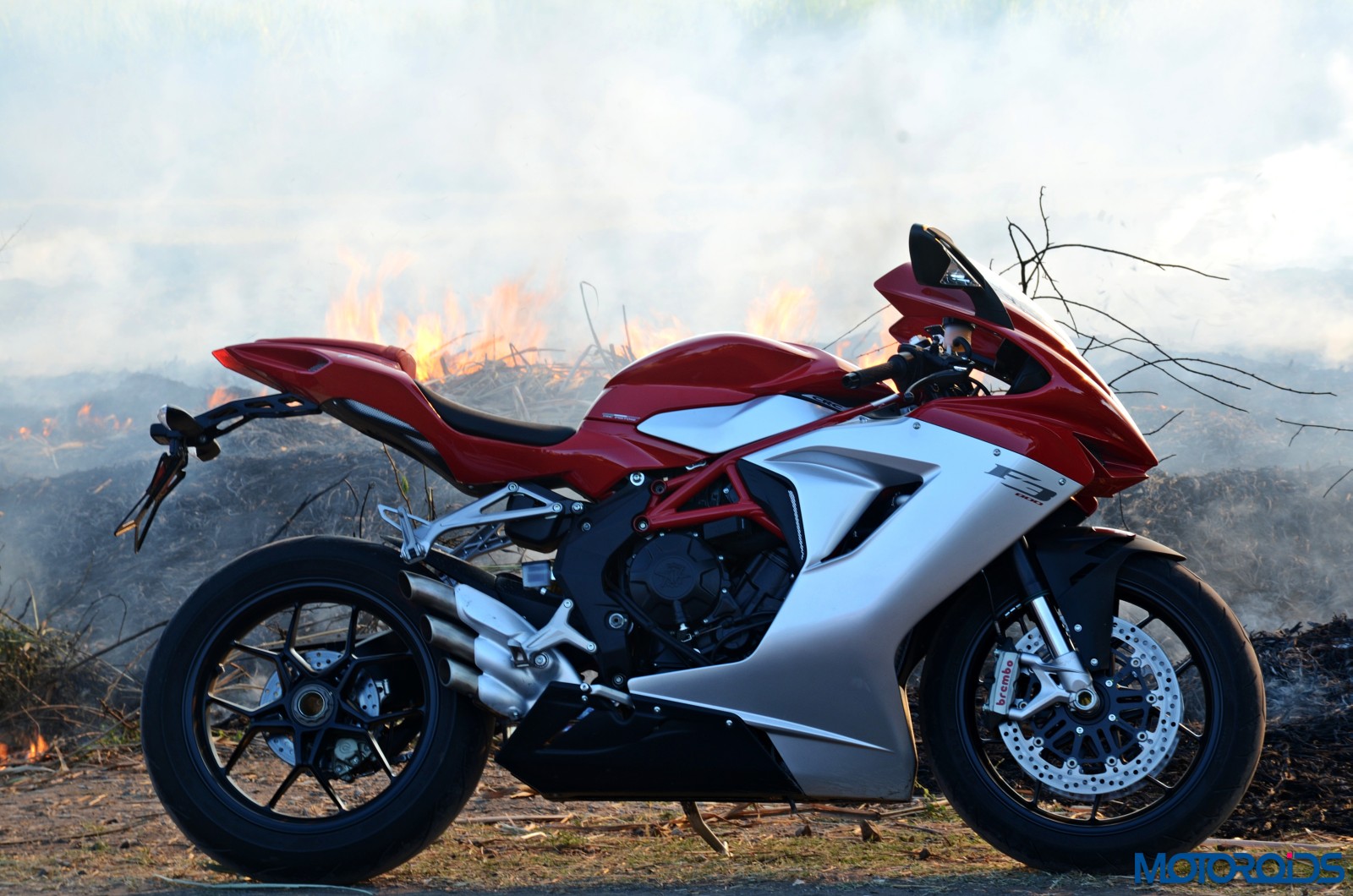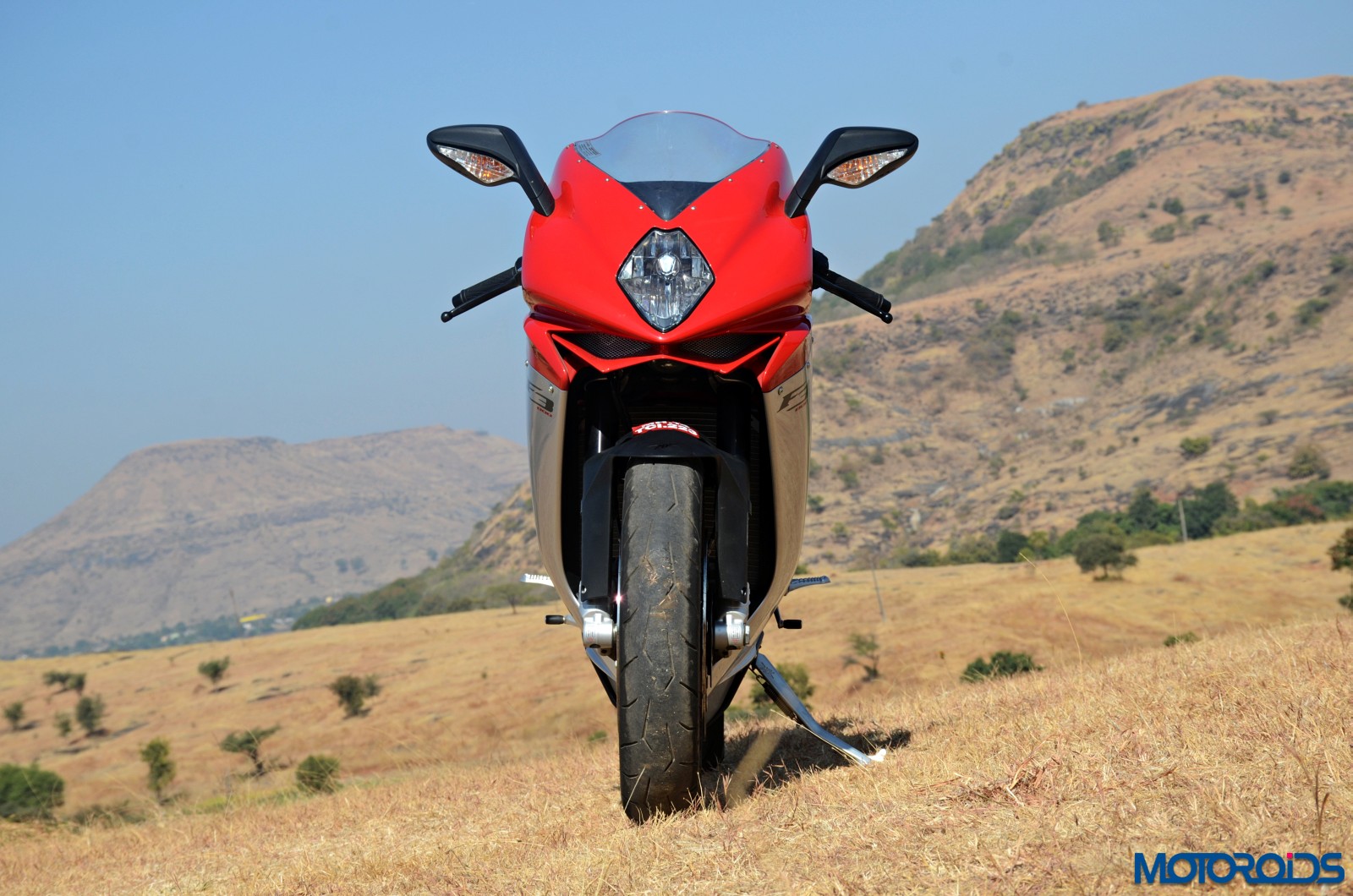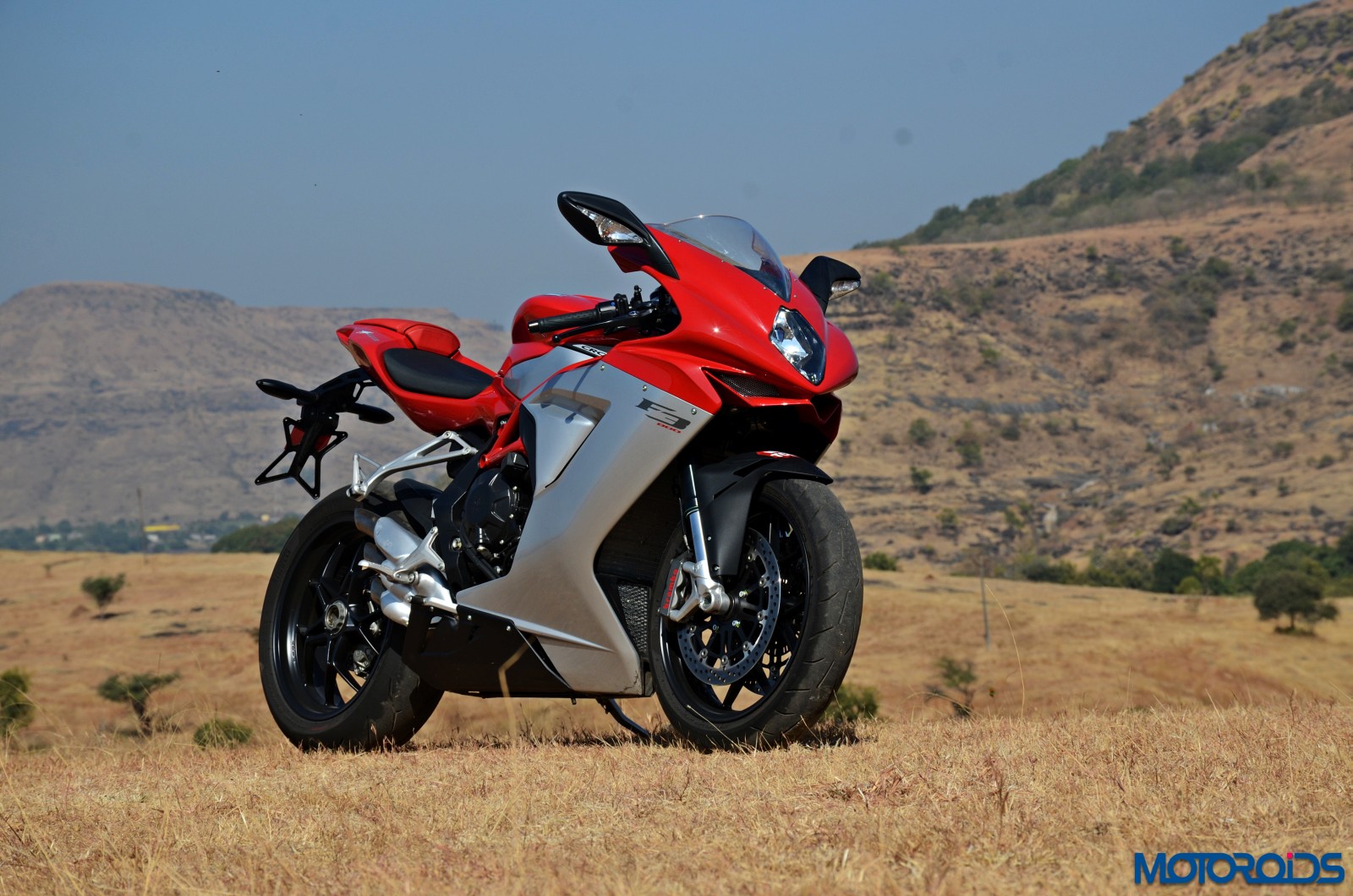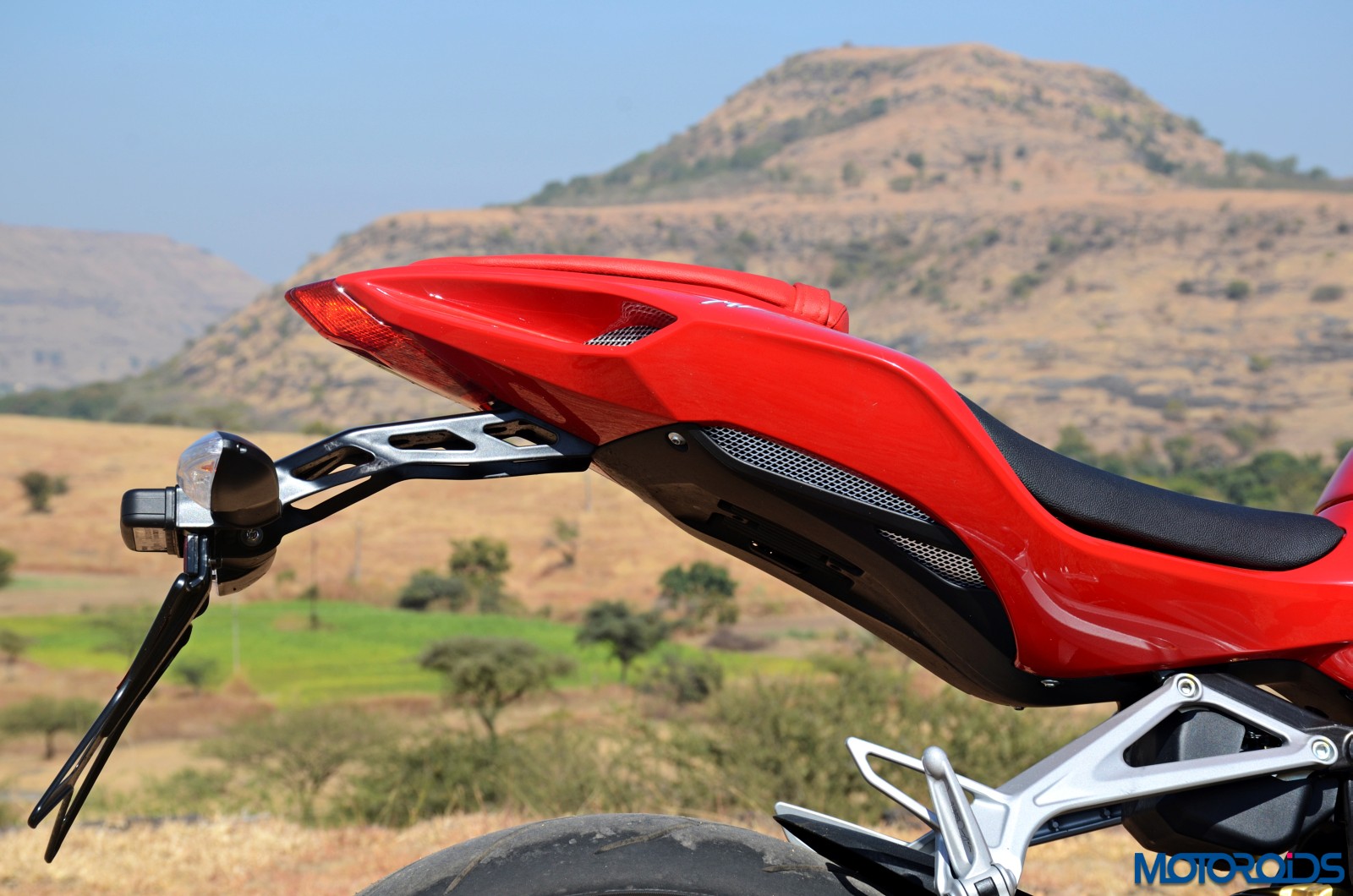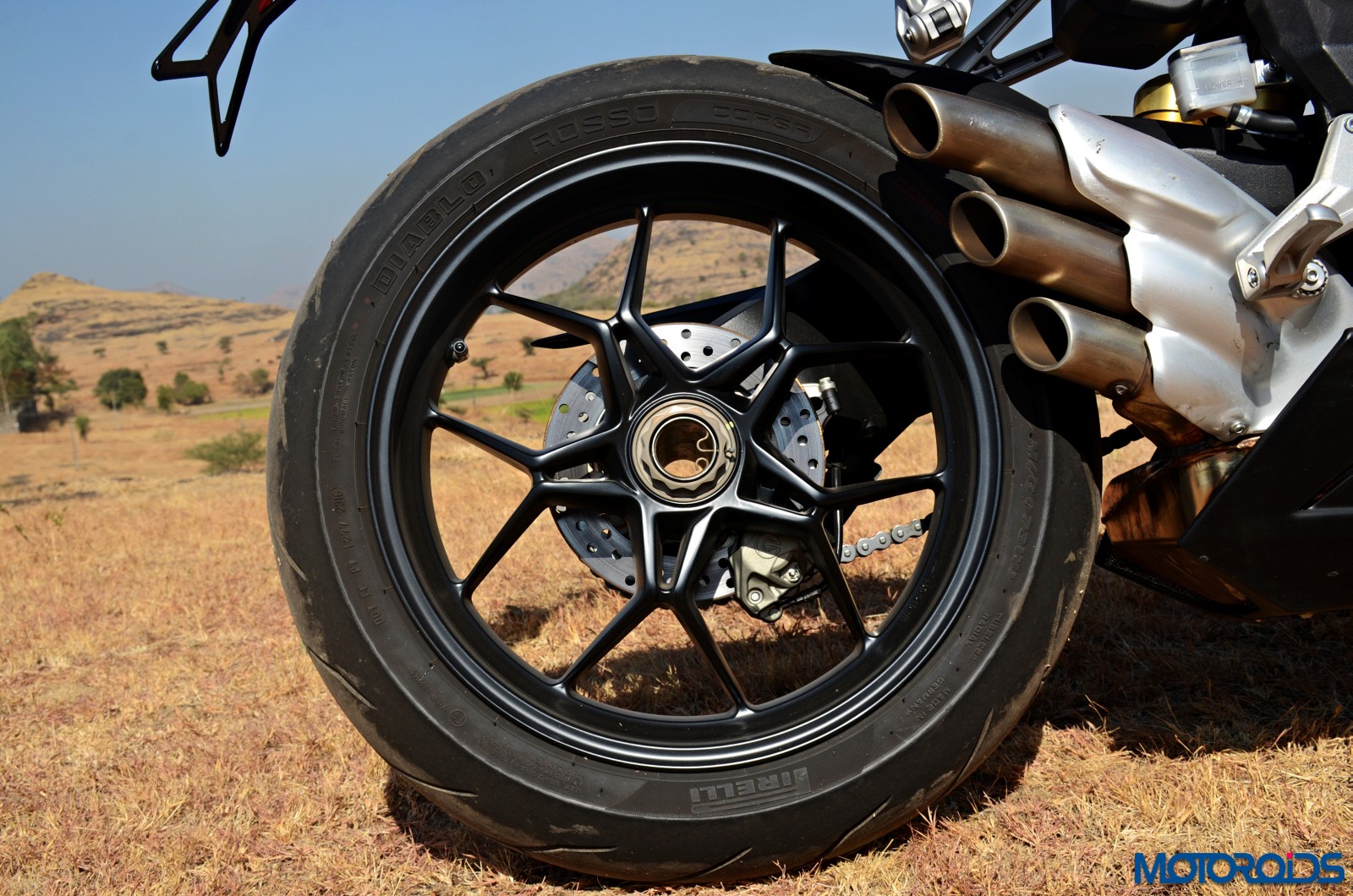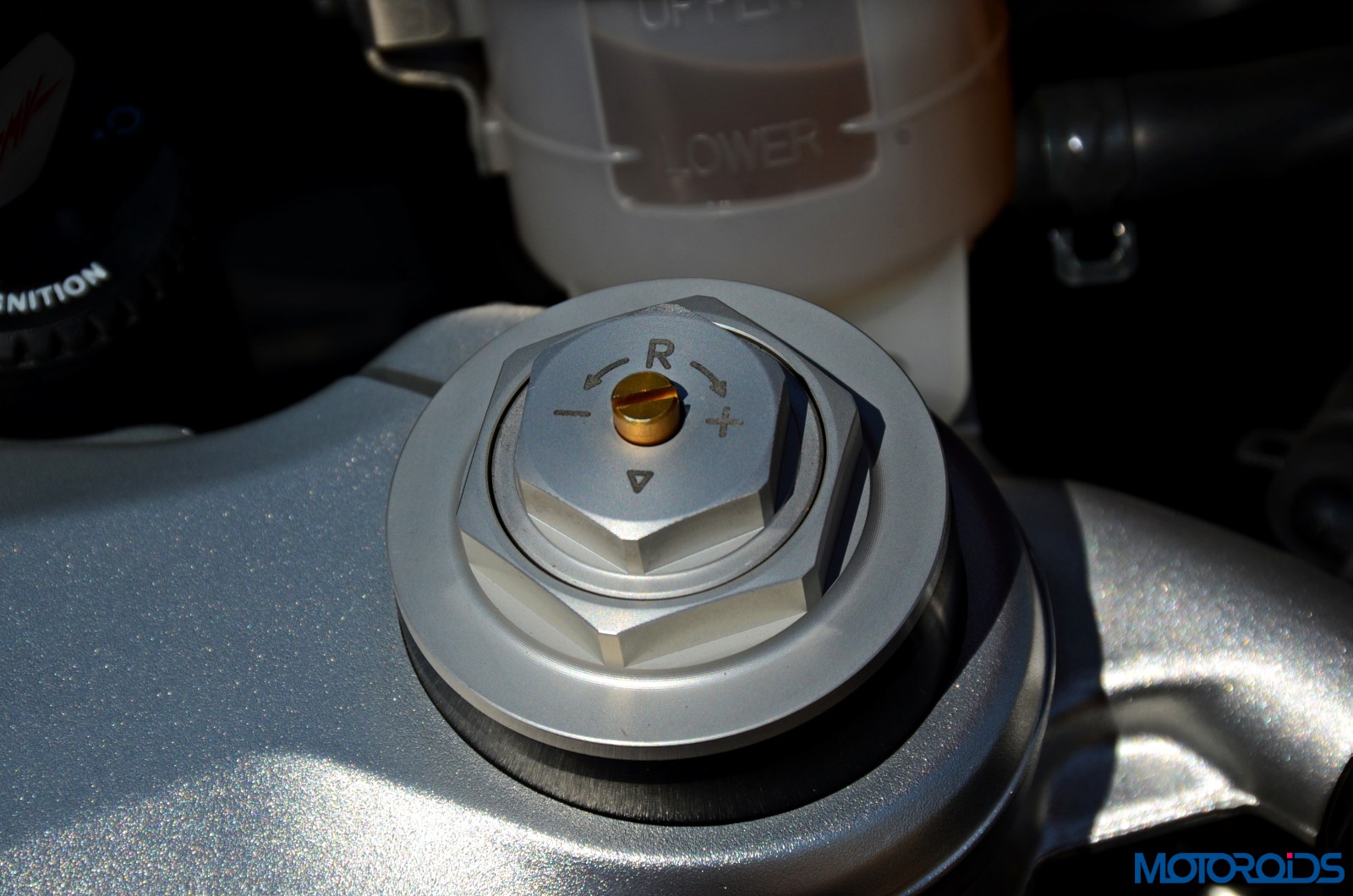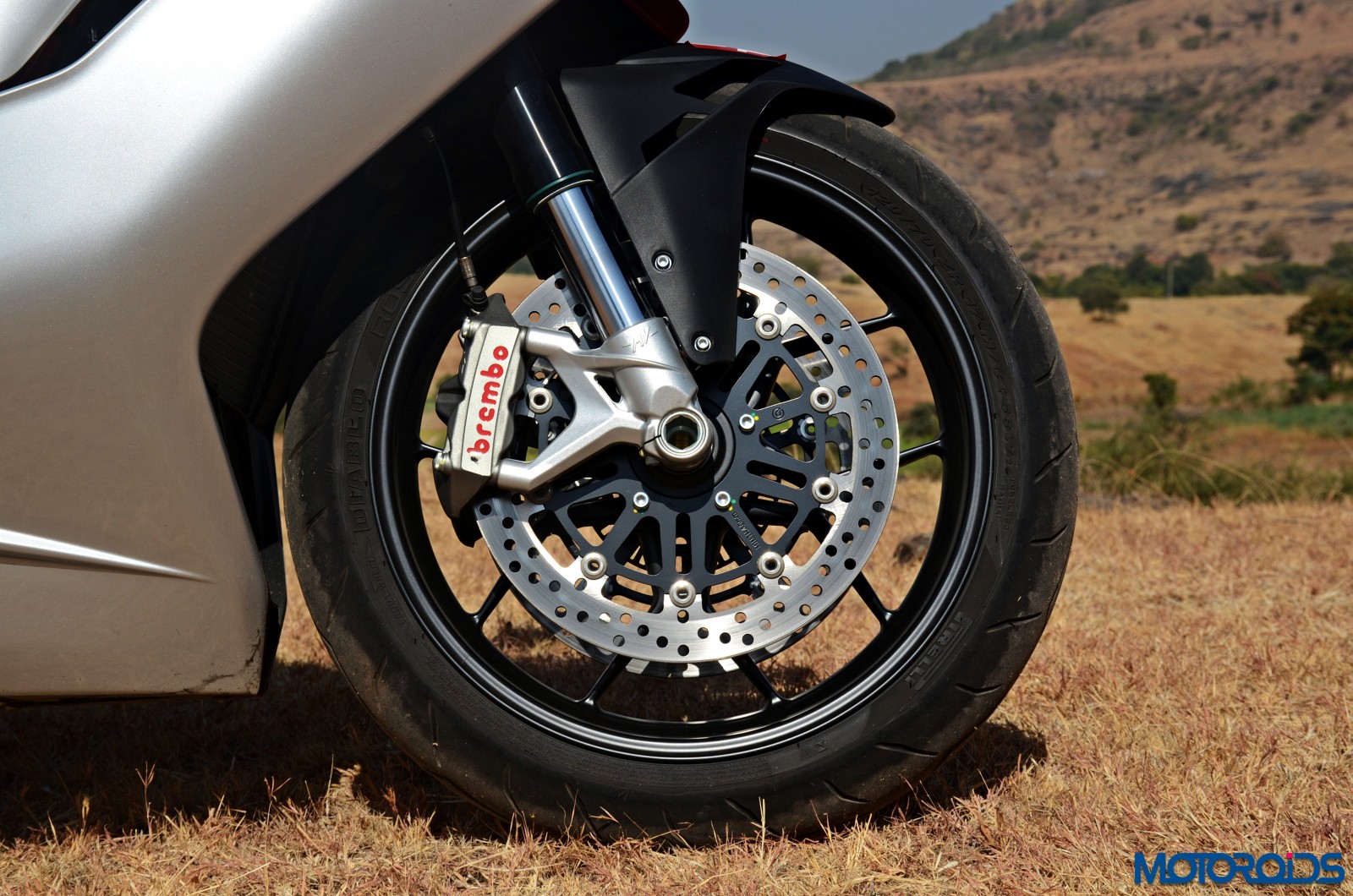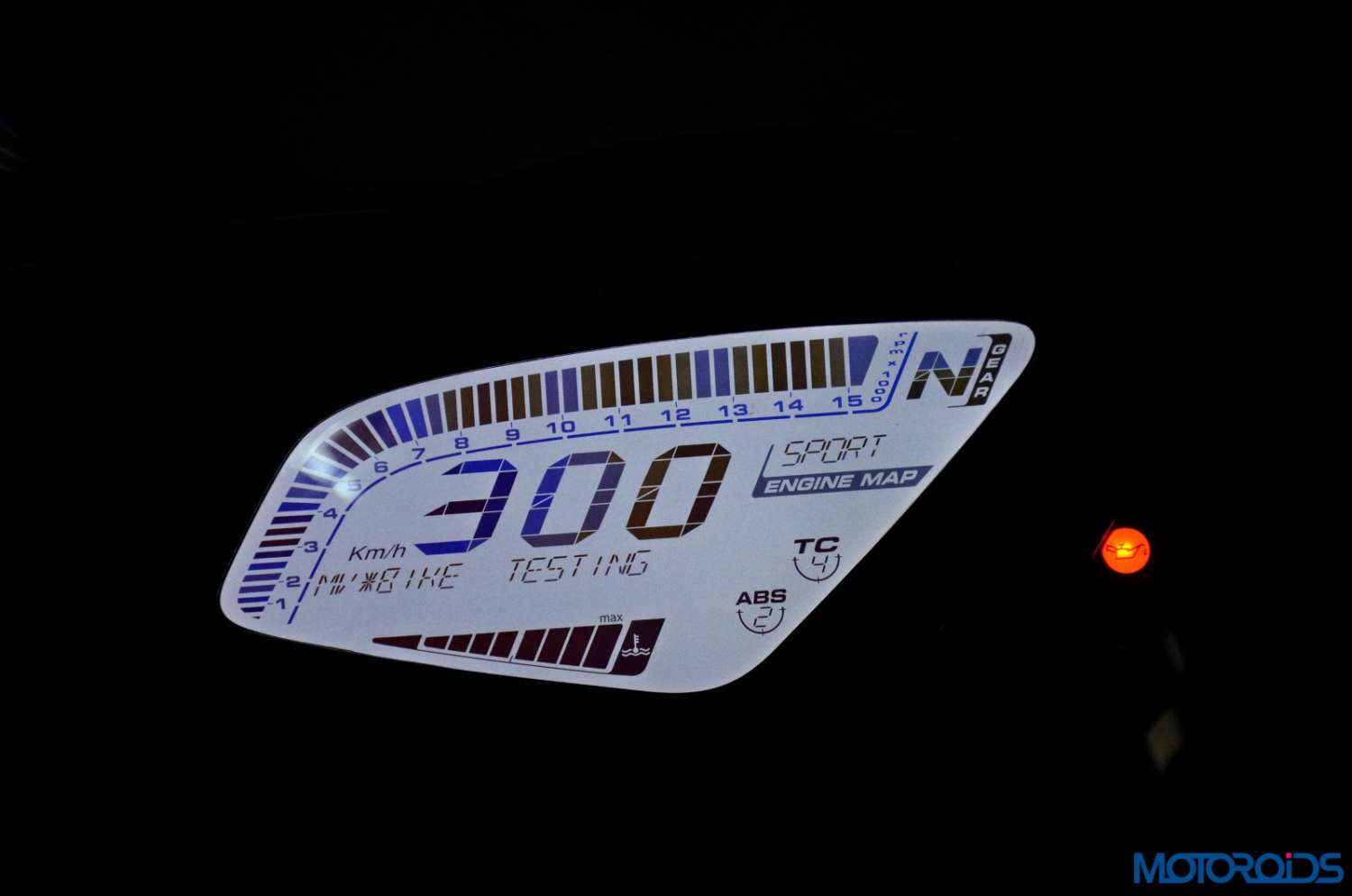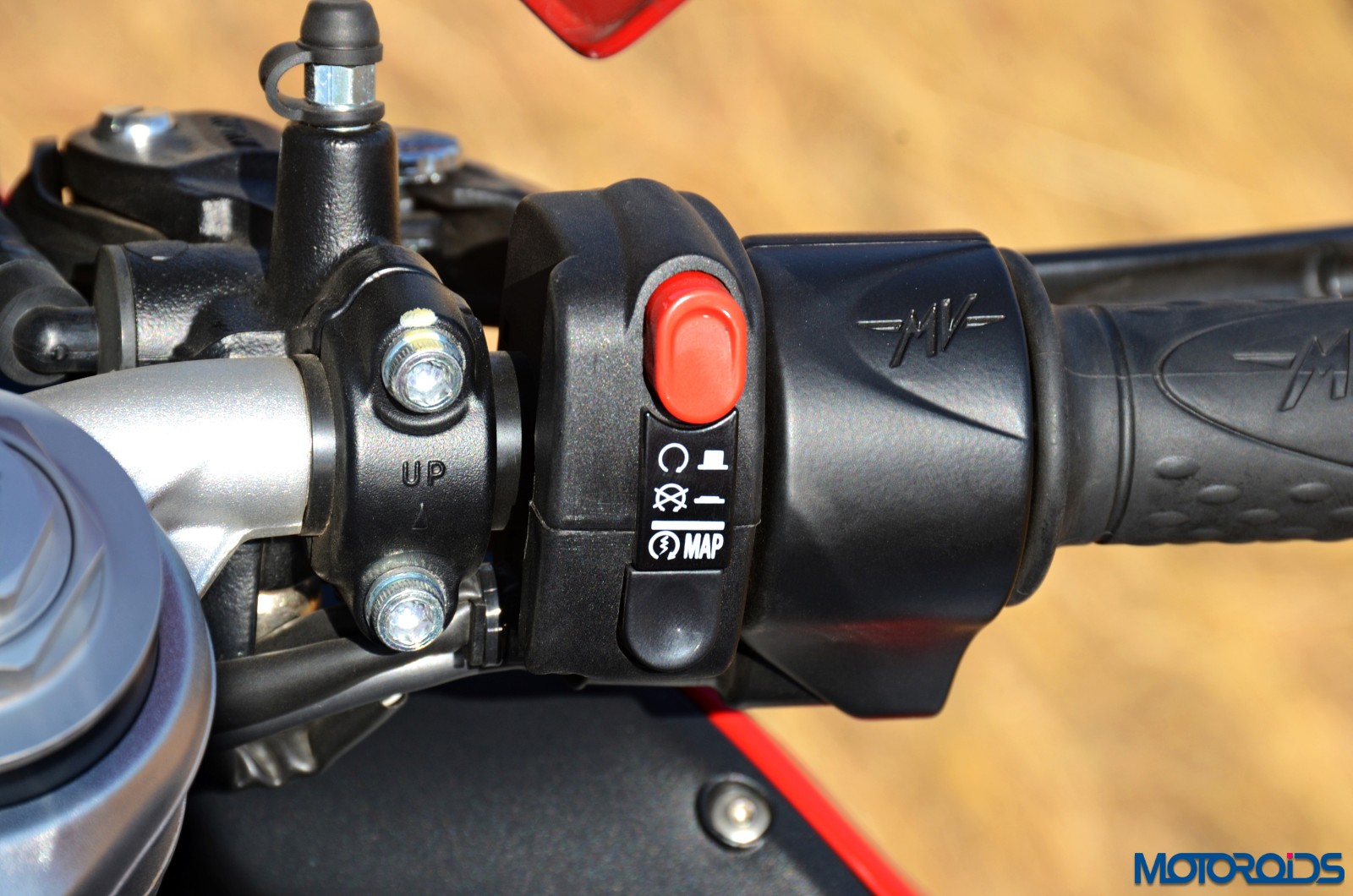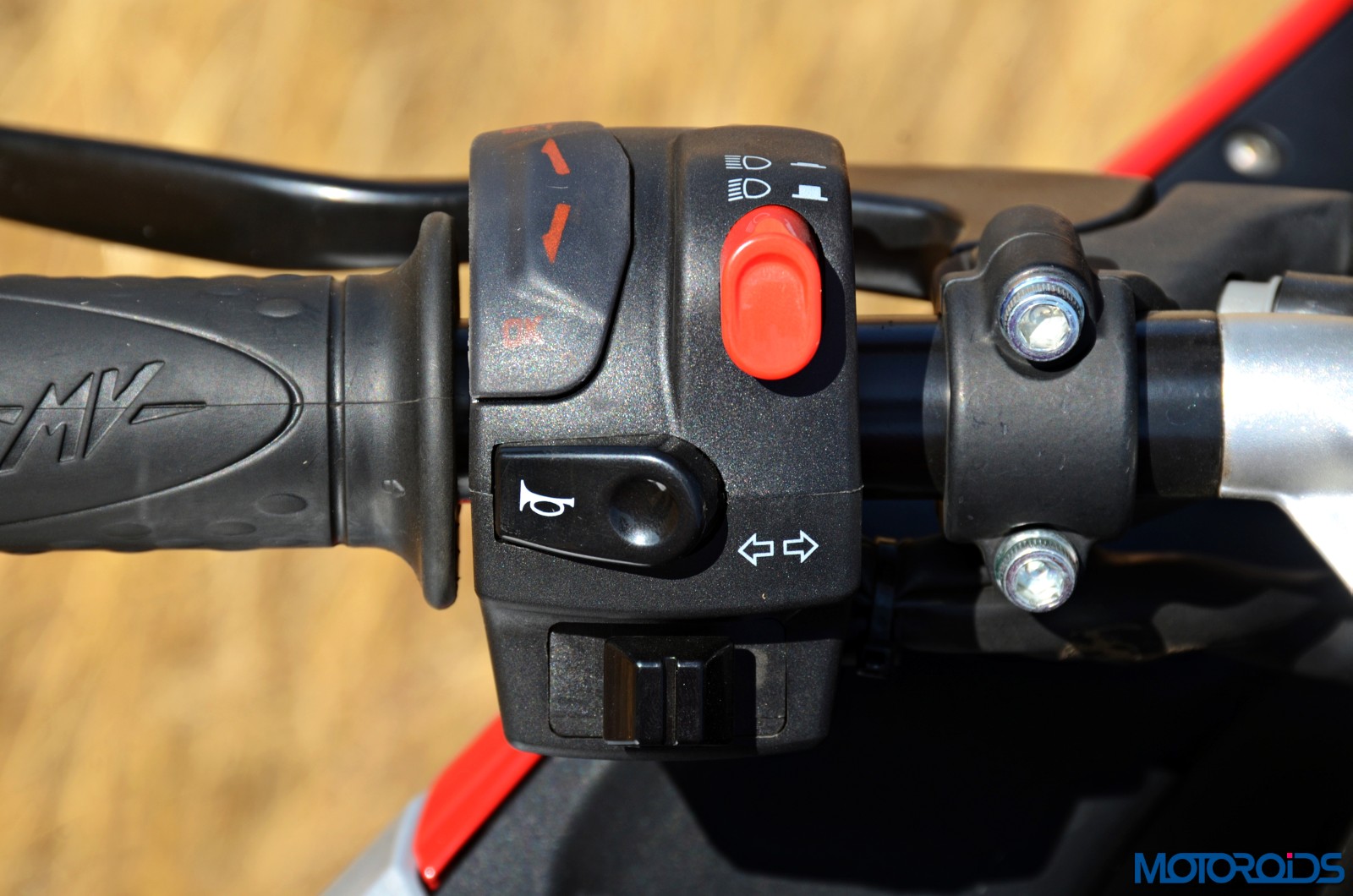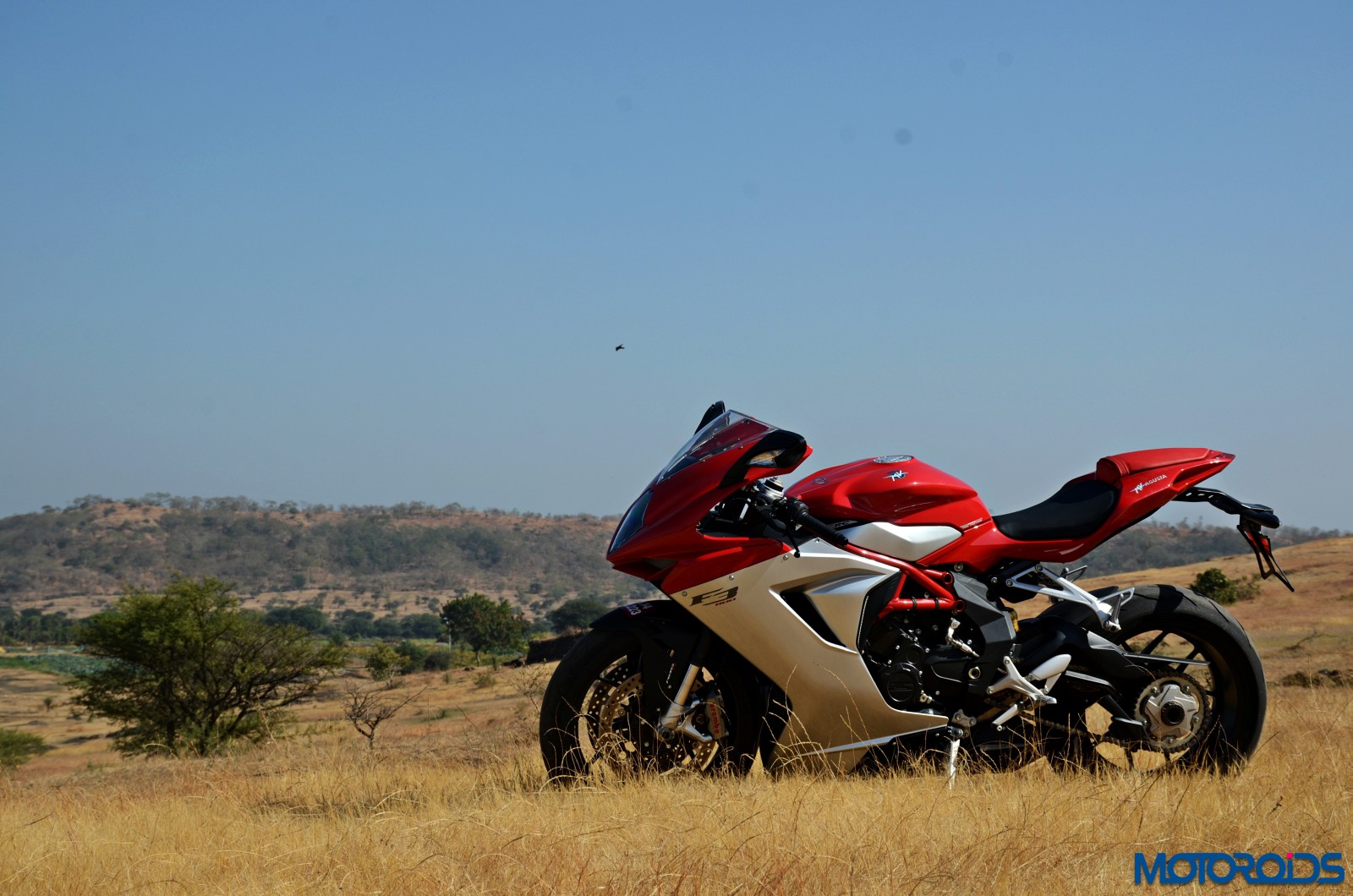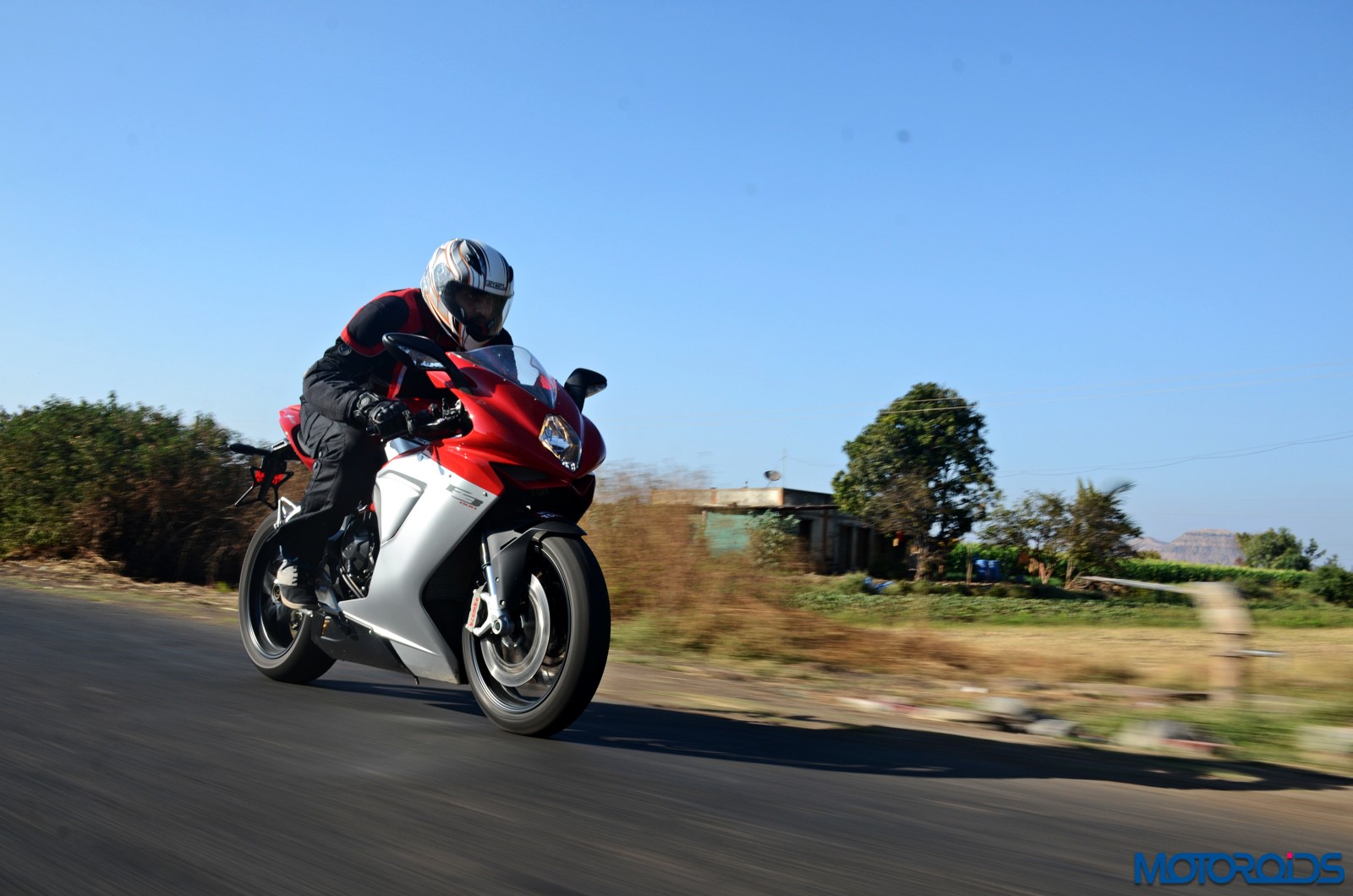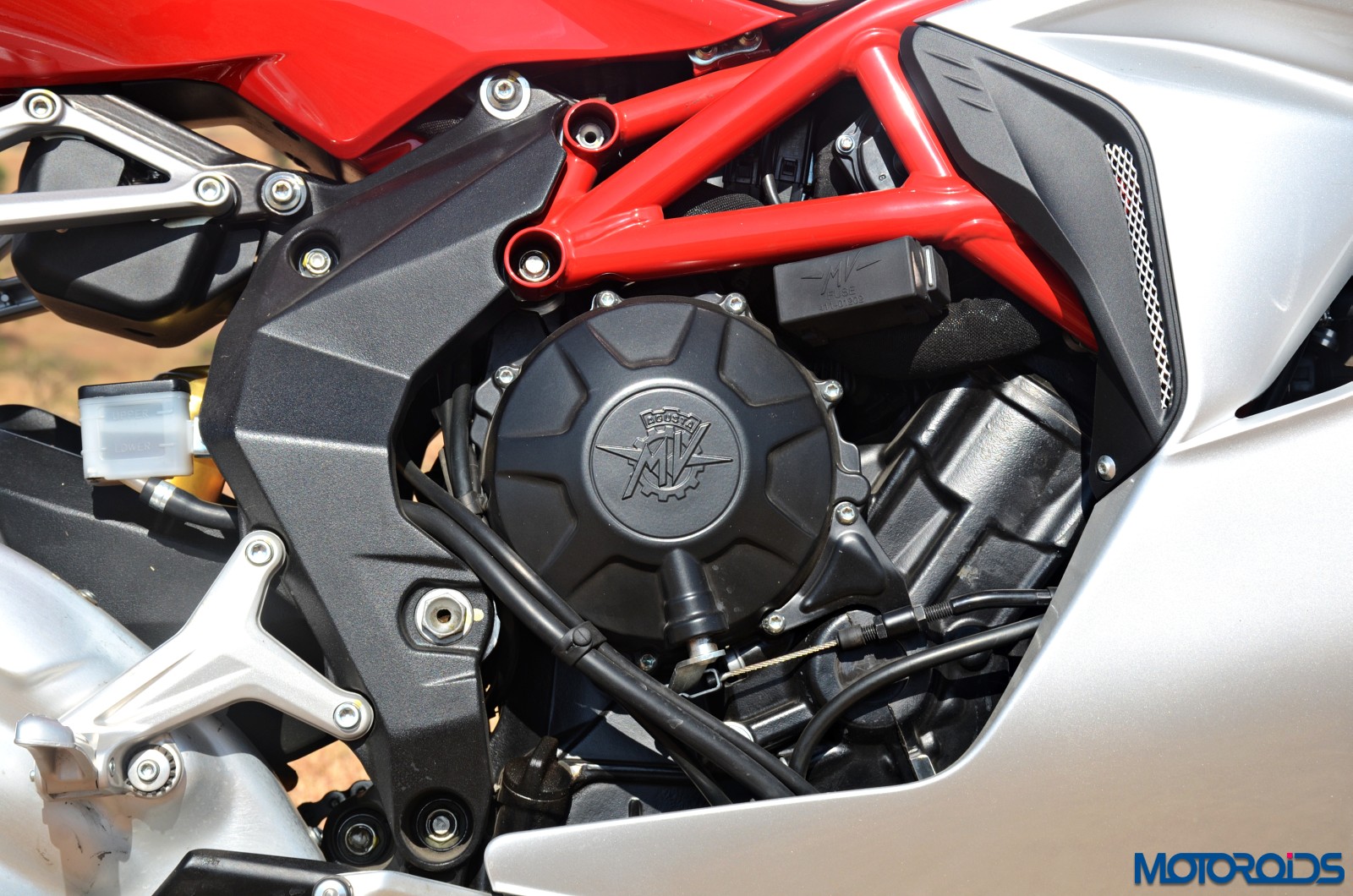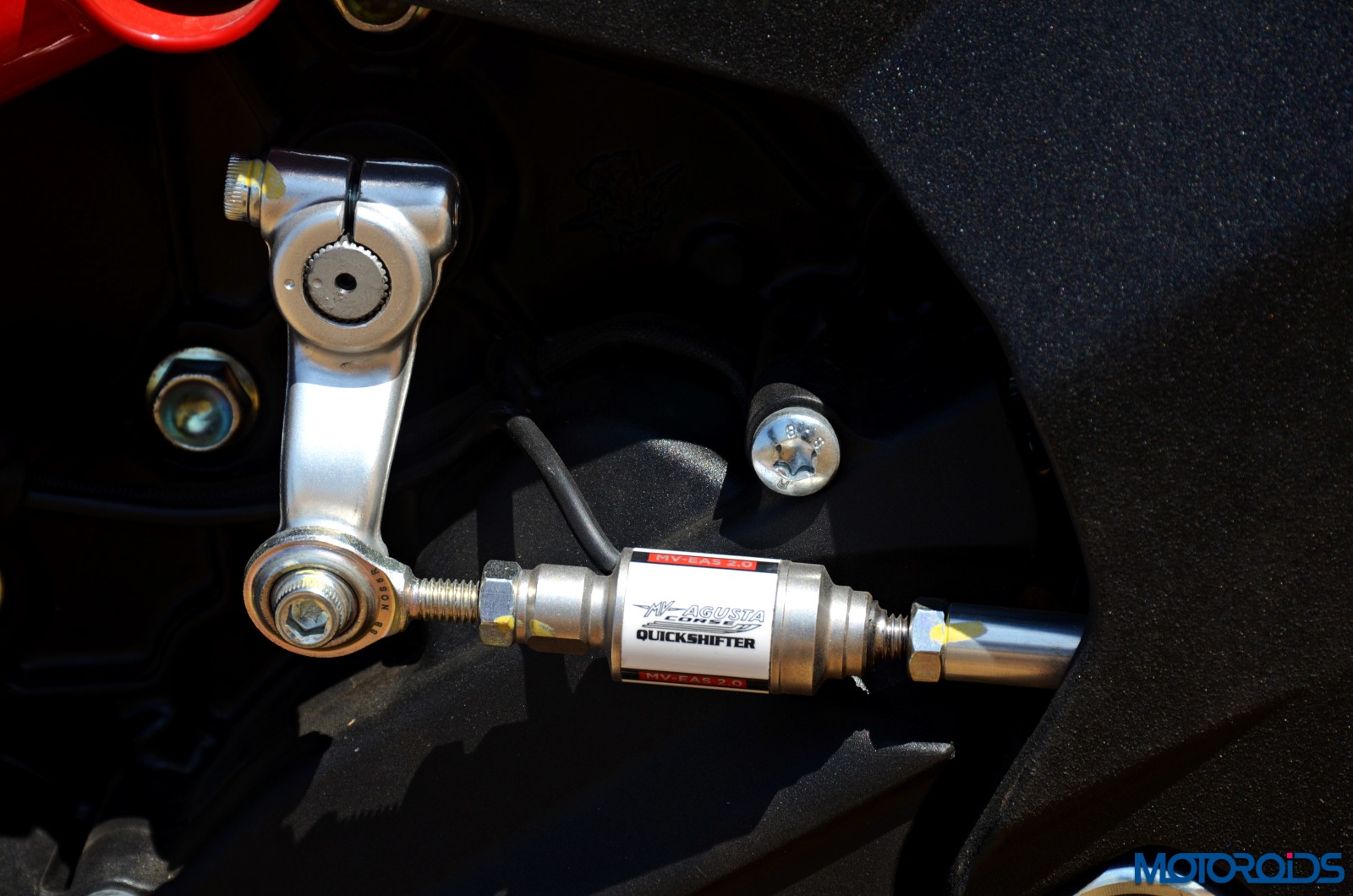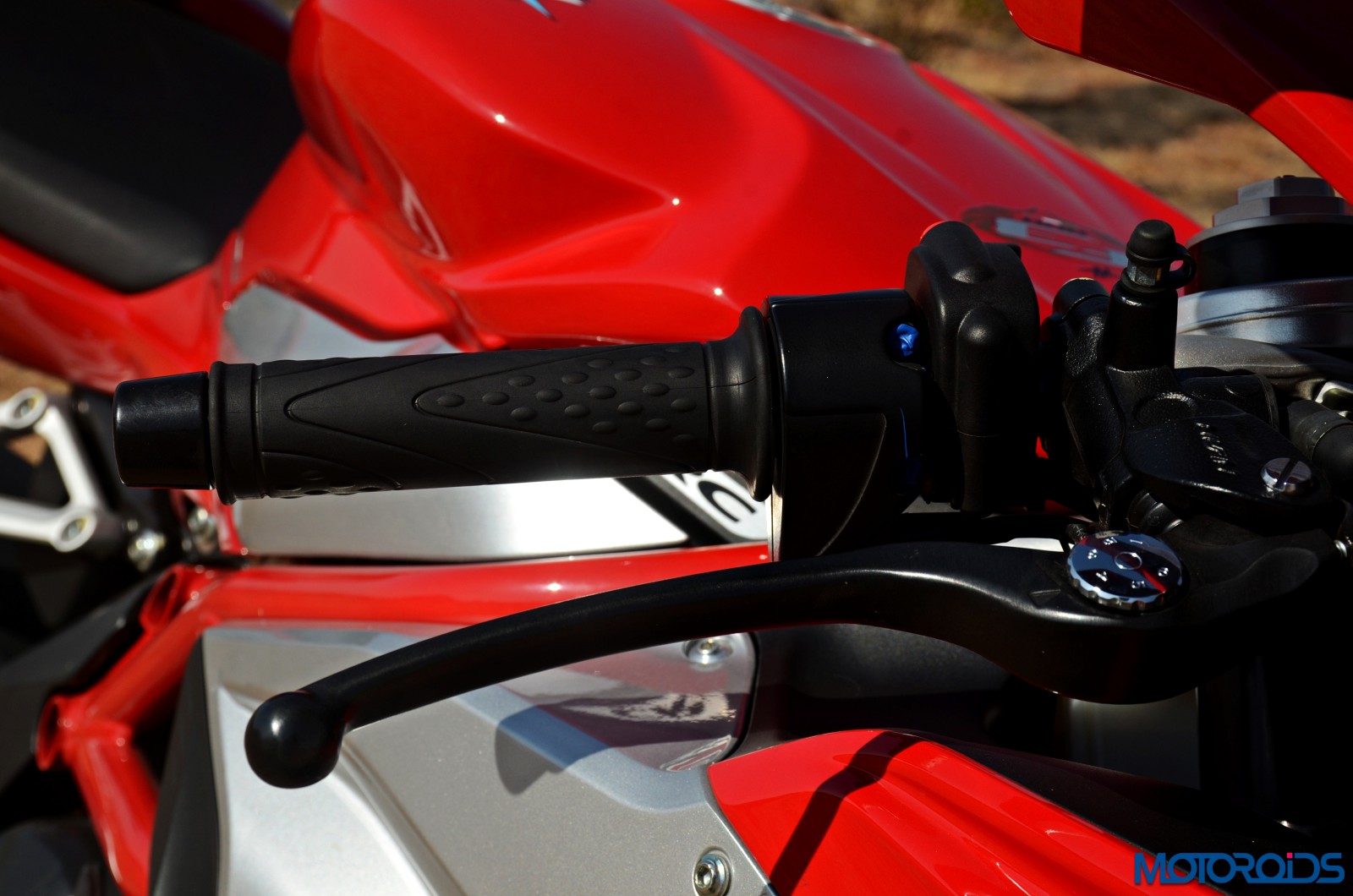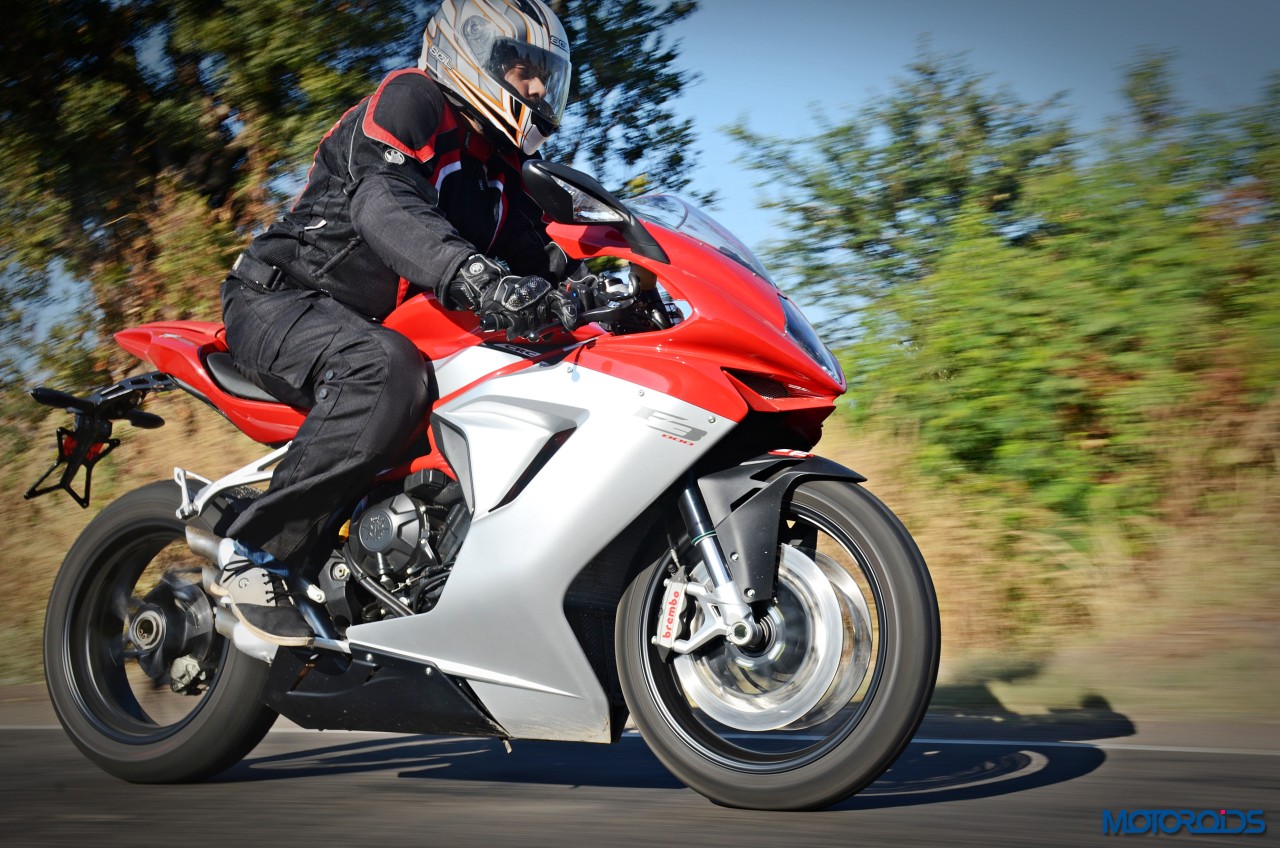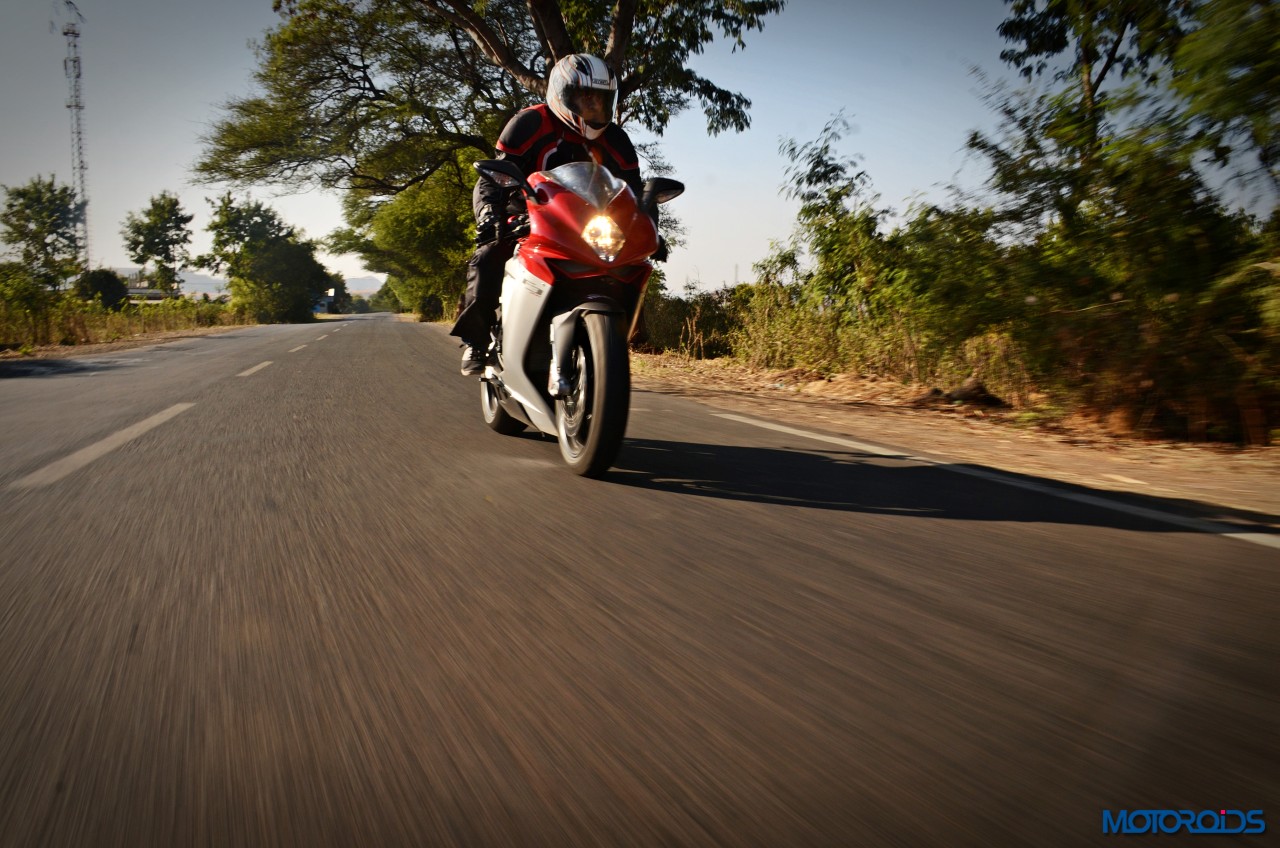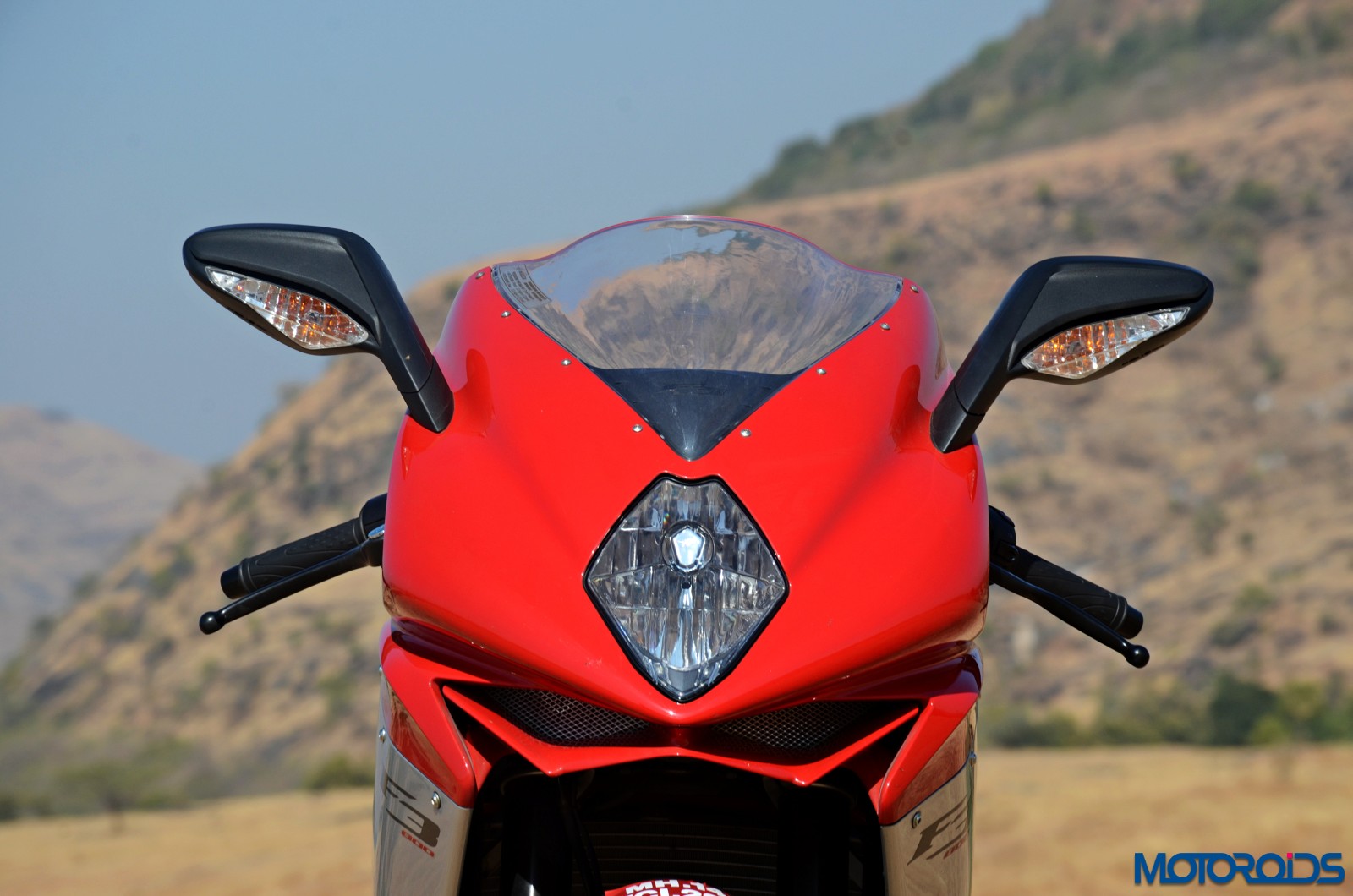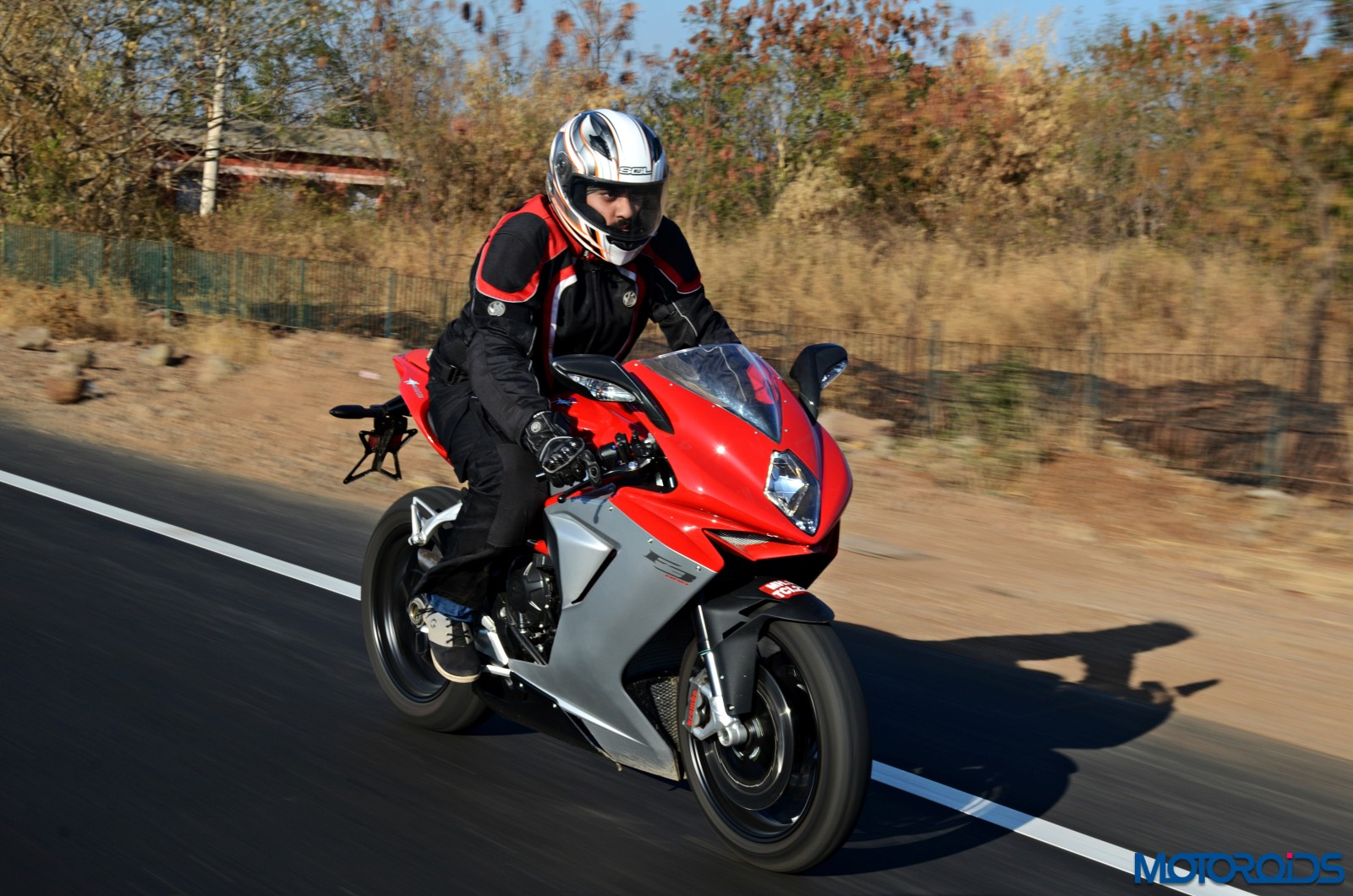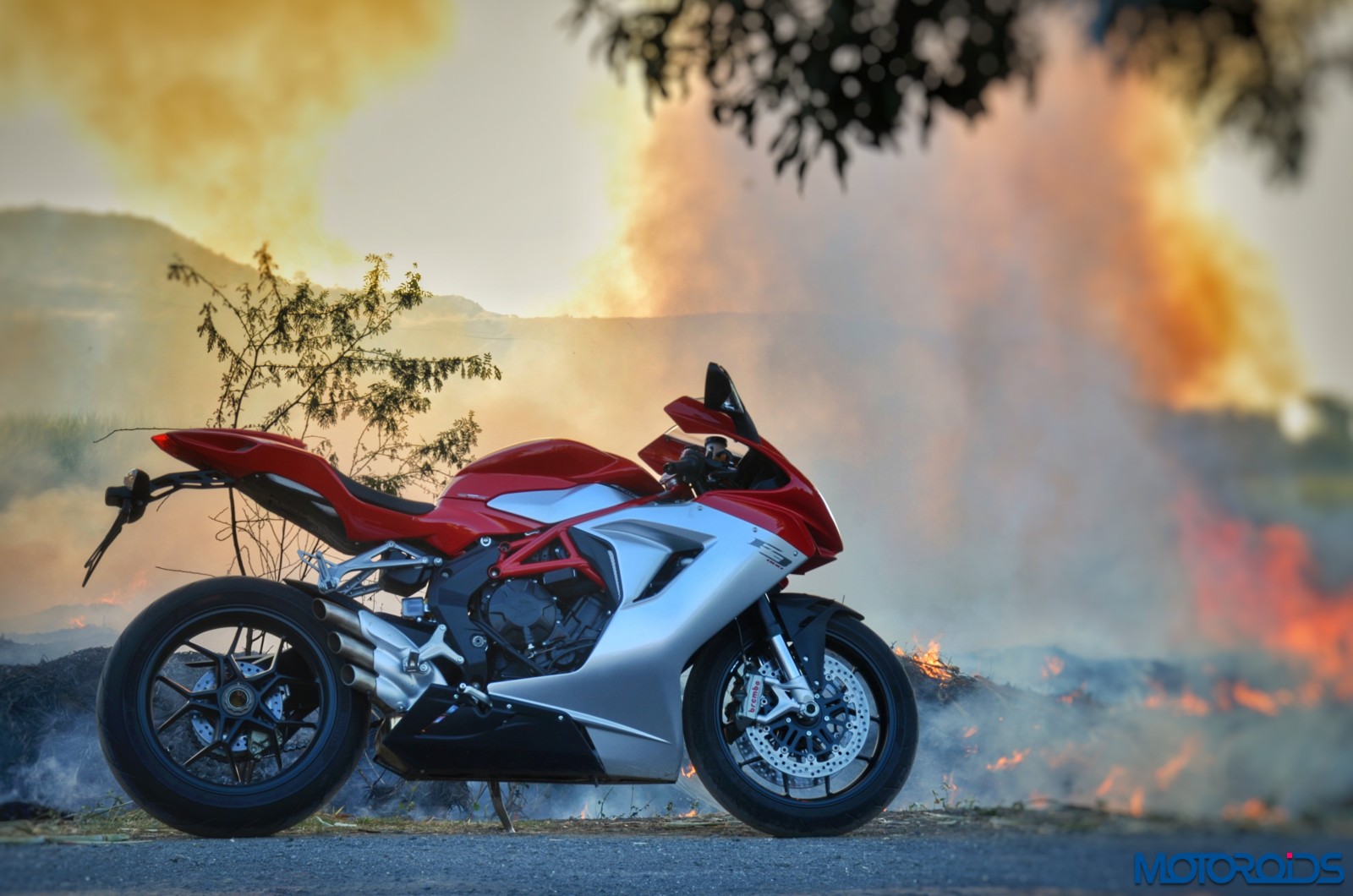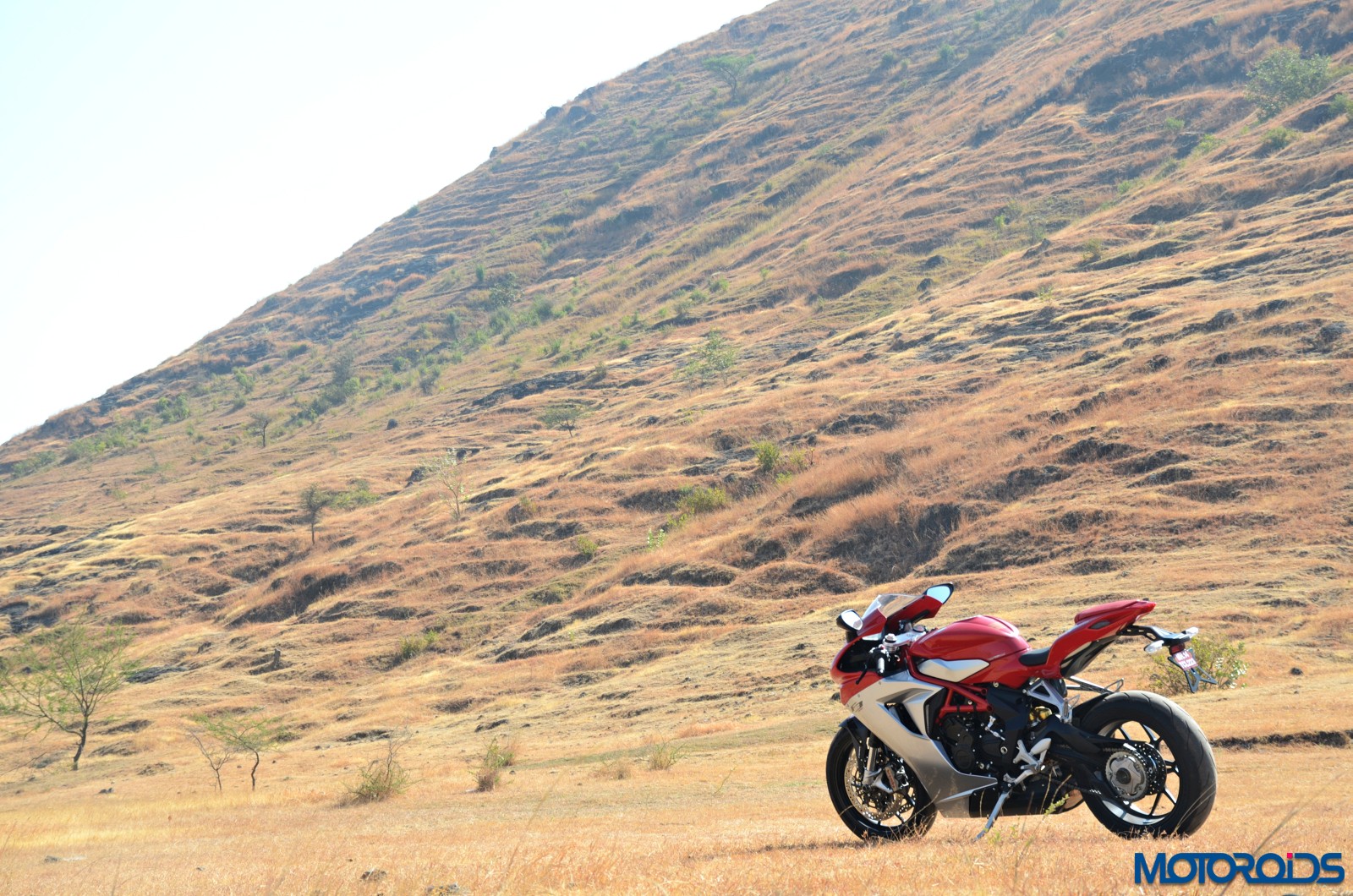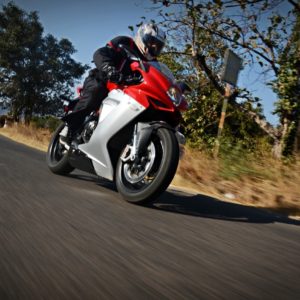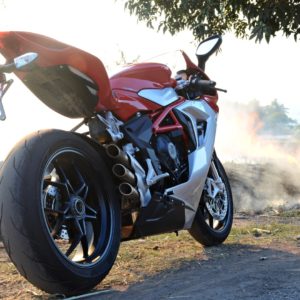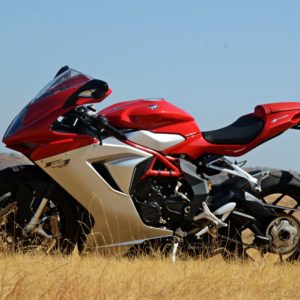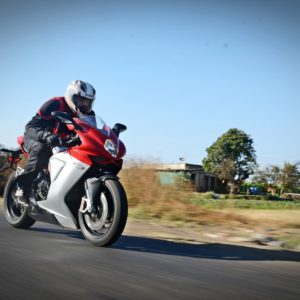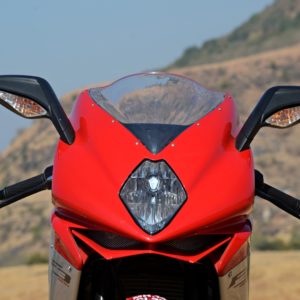Had it been any other day, I wouldn’t have thought twice before pulling over a t-shirt and slipping myself into the jeans I used the previous day to head out for a ride. It wasn’t, however, any other day. We were to welcome two beautiful, and equally wild guests at the Motoroids’ garage and they deserved to be greeted with the best attire and our finest behaviour. We’ll keep the second machine as a surprise for you, but the first one, as you would have figured by now, was the little smaller, and a more practical alternative to the timeless MV Agusta F4. The F3 800, which looks as stunningly beautiful as its bigger sibling, is a more genial rendition of its feral elder.
I was handed over the keys to the Italian masterpiece and left alone with it on a seemingly never-ending piece of smooth patch of freshly laid tarmac on a beautifully cold winter morning. As goes without saying, that day will be etched in my mind as one of the most memorable ones, though I would like to take a moment and admire the beauty of the machine first, before I share my experience with it.
Do check out – MV Agusta F4 R India Review : Monumental Mayhem
MV Agusta F3 800 Design
One glance at the motorcycle and you can see those timeless lines that Massimo Tamburini drew for the F4 pretty clearly. But the F3, as opposed to its litre-segment 195 hp sibling, isn’t as massive. It’s compact, gets a smaller wheelbase which makes it agile – we’d get back to that in a while – and is every bit of motorcycle you’d need for adrenaline filled weekends / track days. Most importantly, though, with its compact dimensions, less power and a relatively less fierce character, its way more usable in the real world as compared to its relentless big brother.
The front fascia has an unmistakable resemblance with the F4. Up front you witness the sleek, aerodynamically efficient headlight in the same geometrical shape as the F4 although with a LED DRL that sits within the reflector panel, unlike the F4 where it finds a place as a pair of strips on the air intakes.
The character lines on the fairing are implausibly beautiful while, at the same time, act as an aerodynamic saviour – more on that later. Under the headlight is a silver mesh grille that covers the air intake.
The front fascia gets a clear look with the ORVMs integrated blinkers. The beautifully carved strokes of the blinkers themselves would leave you awestruck. The front fender, in its stealthy paint, adds contrast to the glossy red paint and is sturdily built.
The character lines from the fairing flow over to the chiselled fuel tank and the result is just magical. while a red painted steel trellis frame peeks out from between the gas tank and the fairing. The dual tone saddle, black for the rider and red for pillion, adds a contrasting view which further enhances the overall beauty of the F3 800. But what’s really interesting in the F3 is the tail section.
The motorcycle does not get an underseat exhaust setup like the F4. Instead, it gets a Brutale 800 style three-pipe outlet on the right side. The exhaust position is aimed to deliver improved mass centralisation. On the other side is the single sided swingarm that makes the F3 800 a proper exotic.
The tail is pretty slim which, in my personal opinion, looks just perfect, and dare I say more proportionate than the F4. The mesh grille at the rear further enhances the visuals although we’re not really sure about their exact role.
The hardware list is pretty feature packed too. The front suspension, for example, is a 43mm Marzocchi upside down telescopic hydraulic fork with rebound-compression damping and spring preload external and separate adjustment. At the rear sits a Progressive Sachs single shock absorber with rebound and compression damping and spring preload adjustment.
Braking duties are performed by M4.34 Brembo monoblock callipers that are razor sharp. Upfront is a 320mm double floating disc with 4 piston calipers while at the rear is a 220mm single disc with 2 piston callipers. We’d talk about their performance later. The motorcycle rides on Aluminium alloy wheels which are wrapped in super sticky Pirelli Sports Demon Corsa tyres.
The compact instrument cluster displays all the necessary information along with the readings for Motor & Vehicle Integrated Control System (MVICS). Apart from the speedometer, tachometer, odometer and trip meter, the instrument cluster also features a gear indicator, selected Engine Map, traction control level, ABS level, engine temperature and a clock. The telltale indicators sit on the extreme right while a side stand indicator and gear-shift indicator are on the right top. The display is pretty neat but going through the MVICS is a bit confusing sometimes.
The motorcycle scores top points in build quality but the switchgear design isn’t the most functional to say the least. Moreover, the select and set button on the left side are a bit difficult to use, especially after putting on the gloves. Setting the traction control level is a bit tricky too. You have to find the setting, bring the traction control to desired level – between zero to eight – and then turn off the motorcycle to complete the process.
The ABS and quickshifter settings are relatively easy. All you have to do is find the specific setting, bring them to desired level and wait for about two seconds to confirm. Changing the engine map is pretty simple too and all you’ll have to do is start the motorcycle and then use the ignition switch to toggle between Sports, Normal, Rain and Custom maps.
As aforementioned, the F3 800 scores top points in build quality. It’s a motorcycle for folks who appreciate the timeless design of the F4 but desire more practicality. It looks astonishing in the flesh, and is decidedly one of the most beautiful motorcycles on sale today.
Also Read – MV Agusta Brutale 800 Review : Milanese bruiser
MV Agusta F3 800 Engine and Performance
The engine is a restroked variant of the MV Agusta F3 675. So while the bore diameter stays at 79.0 mm, the stroke has been increased from 45.9 mm to 54.3 mm which has resulted in an increase in displacement from 675 cc to 798 cc. What they’ve also done is reduced the redline from 15,000 rpm to 13,500 clicks. The new engine delivers 148 hp at 13,000 rpm while the peak torque of 88 Nm arrives at 10,600 rpm.
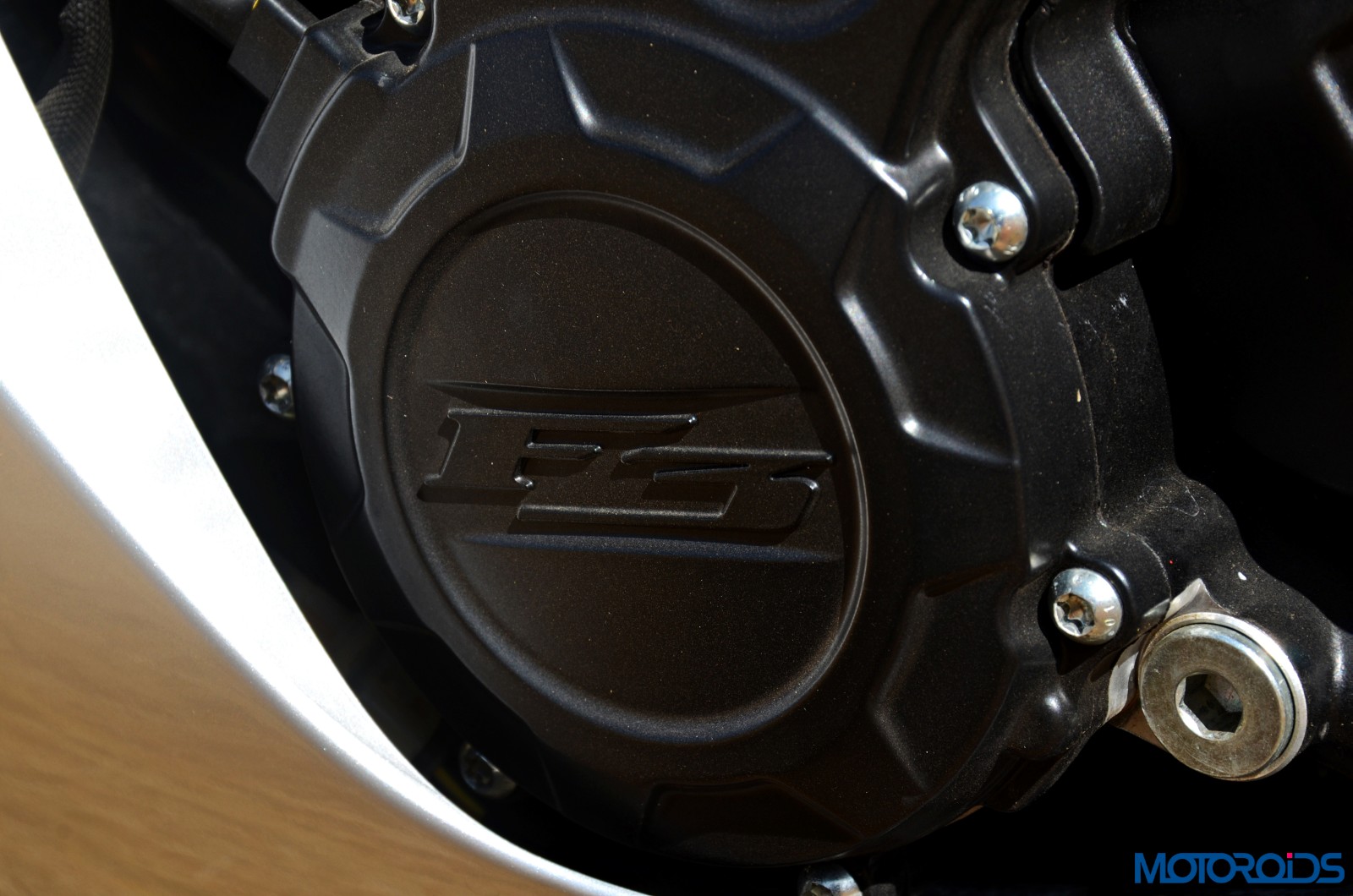
MV Agusta claims to have made improvements to the fuel injectors, which are aimed to ensure higher flow rates than those on the F3 675. This has also solved the rather unpredictable throttle response that dogged the 675. The three-cylinder engine gets counter-rotating crankshaft that is aimed to reduce inertia during quick directional changes. At full chat, the F3 800 is claimed to be good for a top speed of around 269 kph.
Push the ignition switch and you’d be welcomed by a very mechanical engine sound. It’s like metal grinding against metal and we really liked that raw sound. It has a sense of purity about it, and is alluring in its own visceral manner, though the extent of it isn’t comparable to the intimidating roar of the F4. The engine’s character too is far more friendly and manageable than the F4. It’s still a properly thrilling motor but doesn’t have the dark, ominous aura of the F4 around it. It also has a substantial amount of juice in its mid-revs.
So, while the F3 800 doesn’t have any issues trundling about in mid-low revs, the engine really comes alive post 7,000 rpm with another step up post 10,000 clicks and that’s where things get on the verge of going downright mental. With enough courage, you’d see yourself shoot past 100 km/h in first gear itself in less than three second. Drop two more gears and the F3 800 would warp you across the double ton mark in a matter of seconds. It’s an insanely fast machine, and somewhat fuses the litre class fury with the manageable dimensions and handling of a middleweight. The throttle inputs are insanely responsive thanks to the Full Ride-By-Wire system and the F3 800 responds to the slightest twitches of your wrist.
The engine gets four riding modes – Rain, Normal, Sport, and Custom. The selected mode changes the throttle response and amount of engine braking. Keep the settings in Sport mode and you’d get minimum engine braking, a really sensitive throttle and spectacular fireworks from the engine.
For relatively easy riding, you can switch to Normal mode. Rain mode softens the character of the motorcycle and locks the Traction Control level to the highest setting. It was a beautiful winter day with freshly laid tarmac so it’s anybody’s guess which riding mode we rode in for most part of the day.
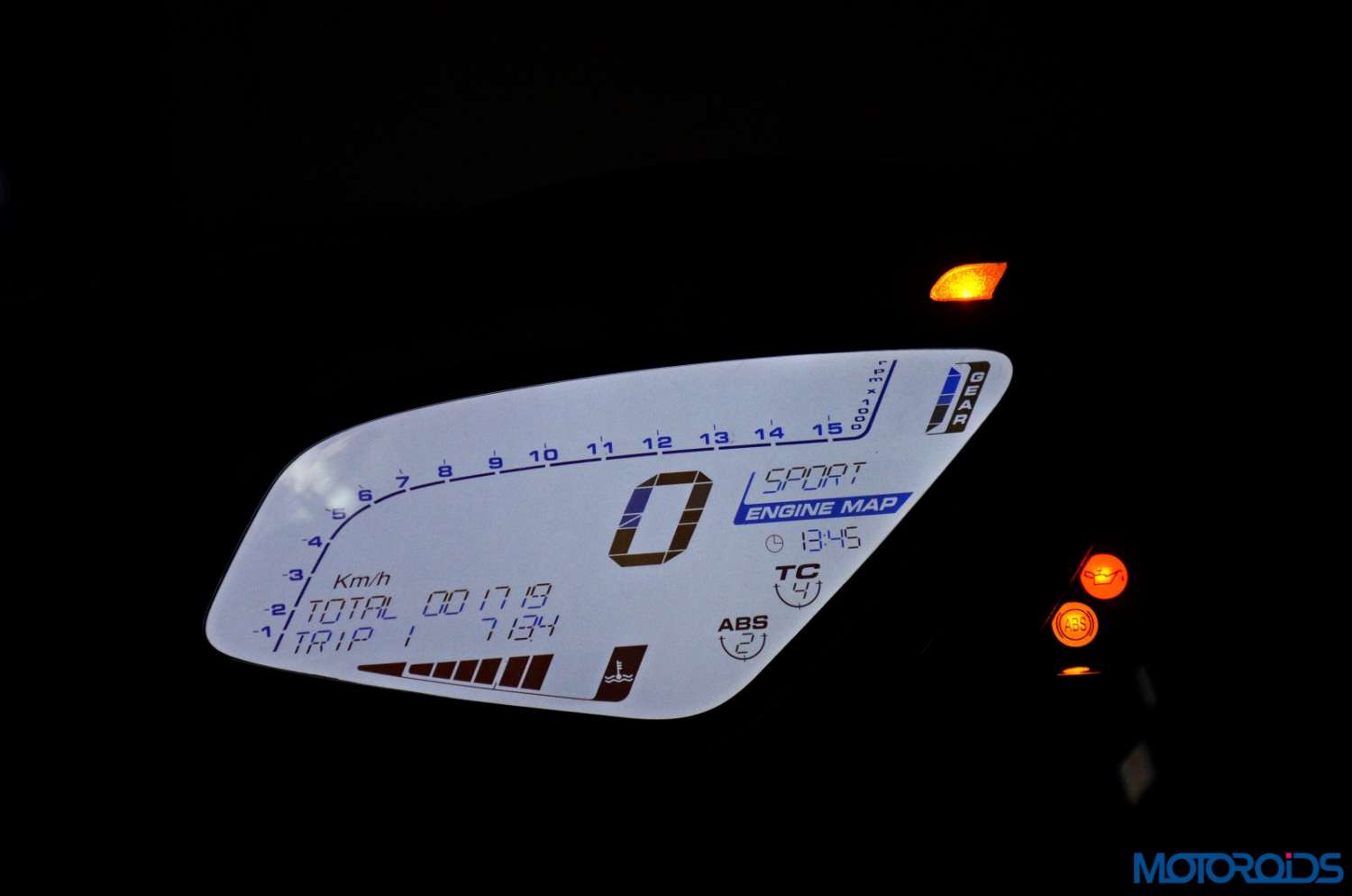
The MV Electronically Assisted Shift, or quickshifter in a layman terms, comes handy for quick upshifts. It does not, however, get a assisted downshift feature but we’d probably see that on the next generation model. It’d take a while to get accustomed to the throttle response at lift off but that shouldn’t take more than a couple of tries for experienced riders. Folks graduating from entry-level segment to middleweight? We’d advice to take it easy for a day or two.
The braking is equally sharp and accurate and you can let your right wrist loose for few extra meters before dropping the anchor. The Brembo sourced braking system is further aided with Bosch 9 Plus Race Mode ABS with Rear wheel Lift-up Mitigation. You can set the ABS in Race mode that offers minimal intrusion and maximum efficiency or opt for Normal which is more, let’s say Family Jewel friendly with the reduced front dive. You can turn it off too if you fancy to lift the rear wheel up.
Speaking of Family Jewels, let’s talk about ride quality.
MV Agusta F3 800 Ergonomics, Ride and Handling
Swing a leg over the saddle and you’d be surprised by the accessibility to terra firma, letting both your feet be firmly placed on the ground. The handlebar, though low set, is remarkably close to the rider. Feet placed fairly behind, and thighs set in the fuel tank recesses, you’d be craving to attack corners. My daily is the long term Apache 200 4V while I ride a KTM 200 Duke over the weekends and both of them have a fairly upright riding stance and I hadn’t ridden a supersport for a while now and yet the F3 800 felt just perfect and I was already pushing it on straights and corners as naturally as I was riding it every day.
Remember that counter-rotating crankshaft we told you about, which is aimed to reduce inertia during quick directional changes? Well, the F3 800, in MV Agusta’s words, gives you “exhilaration of a 1000 cc bike, the handling of a 600.” They take that line very seriously. The F4, as you must have read in our exhaustive review, takes quite some efforts and heavy inputs to push around the corners, especially into chicanes. The F3 800 is far more subservient. Helping the case is its really short wheelbase which stands at just 1380mm and its lightweight body (173 kg dry). The steel trellis frame feels planted as you go from one side to the other. It’s plain ridiculous and almost unbelievable the ease with which you can change directions on the F3 800.
Tuck yourself behind that windscreen and things feel pretty much in control as you nudge manic speeds in a blink. I did, however, dare to pull up my head from the protective shield of the windscreen and was punched in the chest from the massive windblasts that the F3 was saving me against. In effect, that windshield is pretty darned effective, provided you know how to make proper use of it.
As it goes with supersports, the comfort department does take the back seat as the default suspension setting is on the stiffer side. The Marzocchi / Sachs combo on the F3 800 was no different and we did have some spine hammering experience on rough patches but that’s one small compromise we’d make for the handling prowess of the motorcycle. Of course, you can tailor the rebound and compression for a softer setting but we’d let it sit at default configuration. The forward biased riding stance meant some serious strain on the wrists and lower back but you’d get used to it after a few stints. It’s committed, but honestly, is way better than some other extreme riding stances we have witnessed.
In Conclusion
The F3 800 is a delightful machine. It’s properly special and leaves an indelible impression on you with its striking form, effervescent powerplant and rare agility. I rode the F3 800 for almost 6 hours, and I wanted to ride it a lot more when I had to return its keys. It’s an exotic, but one you can, and would want to ride over and over again.
Visually, there aren’t many motorcycles that can hold a candle to the F3 800 and we don’t expect that to change any time soon. The mechanical sound of the motor sounds as pure and unadulterated as motorcycles made with passion should. The electronic package includes just the right things but we really hope they make the settings friendly on the next generation model which is expected to arrive in a year’s time.
The asking price is on the expensive side though, as you’d have to shell out 16.78 big ones (ex-showroom) to bring this beauty home and to be honest, there are some options out there which may lure the sheer value seekers. There’s the relatively more powerful Ducati Panigale 959 which costs INR 13.97 lakh (ex-showroom) or even the litre-segment Kawasaki Ninja ZX10R which comes at a slightly expensive tag of INR 18.10 lakh (ex-showroom). But you don’t buy an MV Agusta only for its performance or its technical prowess. You buy it out of sheer love for motorcycles, and for the sense of pride that you get when people who see you riding acknowledge your refined taste.
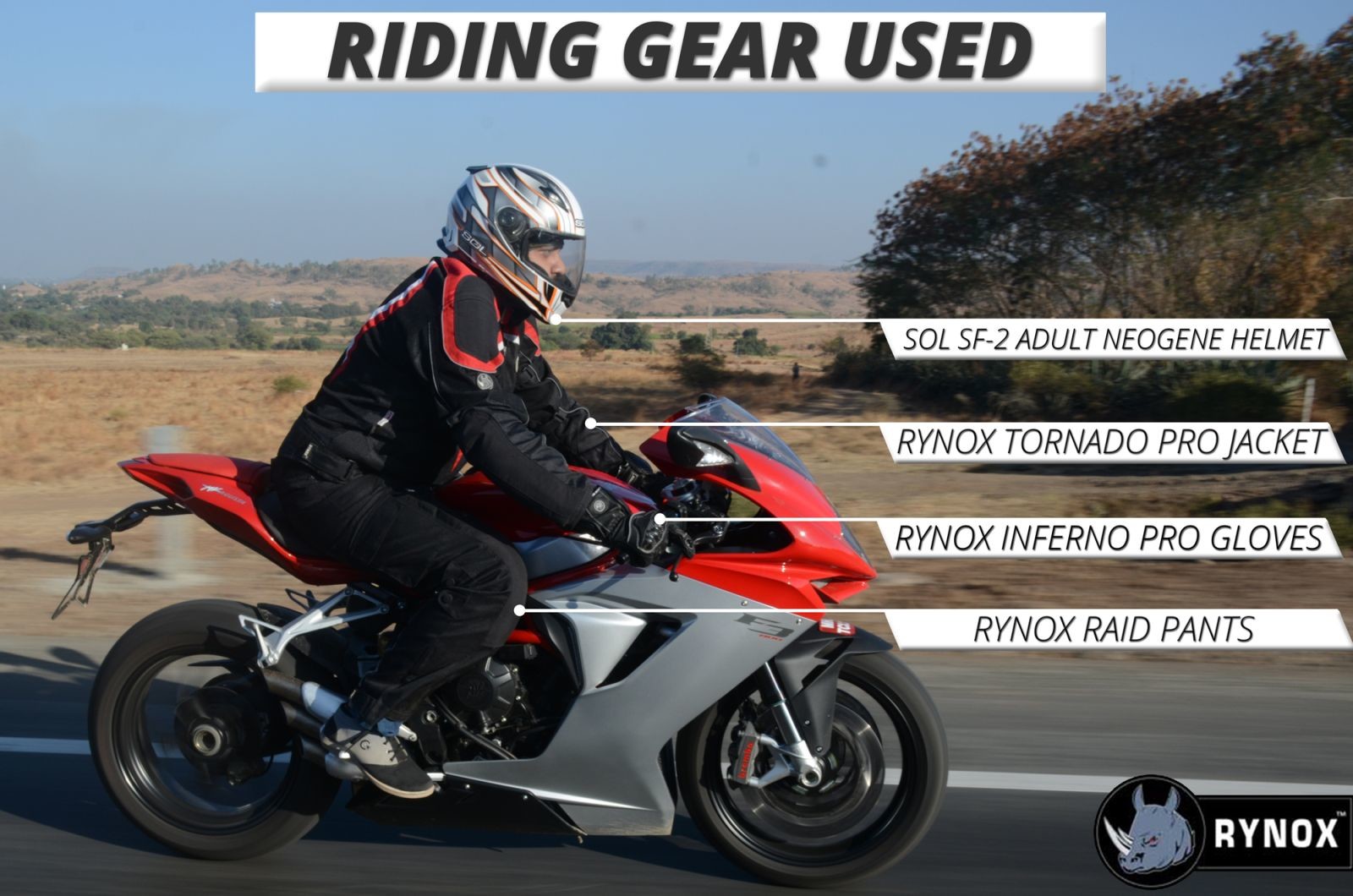
Check out what else they offer and buy your own safety gear at Rynox’s official website
| ENGINE | |
| Type | Three cylinder, 4 stroke, 12 valve |
| Timing system | “D.O.H.C” with mechanical chain tensioner |
| Total displacement | 798 cm3 (48.7 cu. in.) |
| Compression ratio | 13.3:1 |
| Starting | Electric |
| Bore x stroke | 79 mm x 54.3 mm (3.1 in. x 2.1 in.) |
| Max. power- r.p.m. (at the crankshaft) | 108.8 kW (148 hp) at 13.000 r.p.m. |
| Max. torque – r.p.m. | 88 Nm (8.97 kgm) at 10.600 r.p.m. |
| Claimed maximum speed | 269.0 km/h (167.1 mph) |
| Cooling system | Cooling with separated liquid and oil radiators |
| Engine management system | Integrated ignition – injection system MVICS (Motor & Vehicle Integrated Control System) with six injectors Engine control unit Eldor EM2.0, throttle body full drive by wire Mikuni, pencil-coil with ion-sensing technology, control of detonation and misfire Torque control with four maps, Traction Control with eight levels of intervention |
| Electronic quick shift | MV EAS 2.0 (Electronically Assisted Shift) |
| Clutch | Wet, multi-disc slipper clutch |
| Transmission | Six speed, constant mesh |
| Primary drive | 19/36 |
| GEAR RATIO | |
| First gear: | 13/37 |
| Second gear: | 16/34 |
| Third gear: | 18/32 |
| Fourth gear: | 19/30 |
| Fifth gear: | 21/30 |
| Sixth gear: | 22/29 |
| Final drive ratio | 17/43 |
| DIMENSIONS AND WEIGHT | |
| Wheelbase | 1380 mm (54.33 in.) |
| Overall length | 2060 mm (81.01 in.) |
| Overall width | 725 mm (28.54 in.) |
| Saddle height | 805 mm (31.69 in.) |
| Min. ground clearance | 125 mm (4.92 in.) |
| Trail | 99 mm (3.89 in.) |
| Dry weight | 173 kg (381.4 lbs.) |
| Fuel tank capacity | 16.5 l (4.36 U.S. gal.) |
| FRAME | |
| Type | ALS Steel tubular trellis |
| Rear swing arm pivot plates material | Aluminium alloy |
| SUSPENSION | |
| Front | Marzocchi “UPSIDE DOWN” telescopic hydraulic fork with rebound-compression damping and spring preload external and separate adjustment |
| Fork dia. | 43 mm (1.69 in.) |
| Fork travel | 125 mm (4.92 in.) |
| Rear | Progressive Sachs, single shock absorber with rebound and compression damping and spring preload adjustment |
| Single sided swing arm material | Aluminium alloy |
| Wheel travel | 123 mm (4.84 in.) |
| BRAKES | |
| Front brake | Double floating disc with Ø 320 mm (Ø 12.6 in.) diameter, with steel braking disc and flange |
| Front brake caliper | Brembo radial-type monobloc, with 4 pistons Ø 34 mm (Ø 1.34 in.) |
| Rear brake | Single steel disc with Ø 220 mm (Ø 8.66 in.) dia. |
| Rear brake caliper | Brembo with 2 pistons – Ø 34 mm (Ø 1.34 in.) |
| ABS System | Bosch 9 Plus with Race Mode and RLM (Rear wheel Lift-up Mitigation) |
| WHEELS | |
| Front: Material/size | Aluminium alloy 3.50 ” x 17 ” |
| Rear: Material/size | Aluminium alloy 5.50 ” x 17 ” |
| TYRES | |
| Front | 120/70 – ZR 17 M/C (58 W) |
| Rear | 180/55 – ZR 17 M/C (73 W) |
| Fairing Material | Thermoplastic |
| Price (Ex-showroom) | INR 16.78 lakh |

